Rob Hallstrom, Rex Hibbert and Paul Dick, call themselves the “3 Old Guys.” They’ve embarked on a 4,000 mile adventure traveling from Grand Rapids, MN to Fairbanks, Alaska via three equally prepped 2023 Norseman X 800 Arctic Cat snowmobiles. You can follow their journey on their Facebook page: 3 Old Guys Ride To Alaska. If you don’t follow Facebook, you can read about DAY 1-8 Here and DAYS 9-22 Here and Days 23-31 are below. Spoiler Alert!…the fellas have officially made it to Fairbanks, and Ill recap DAYS 32-39 next week. What a story and achievement!! – Kale
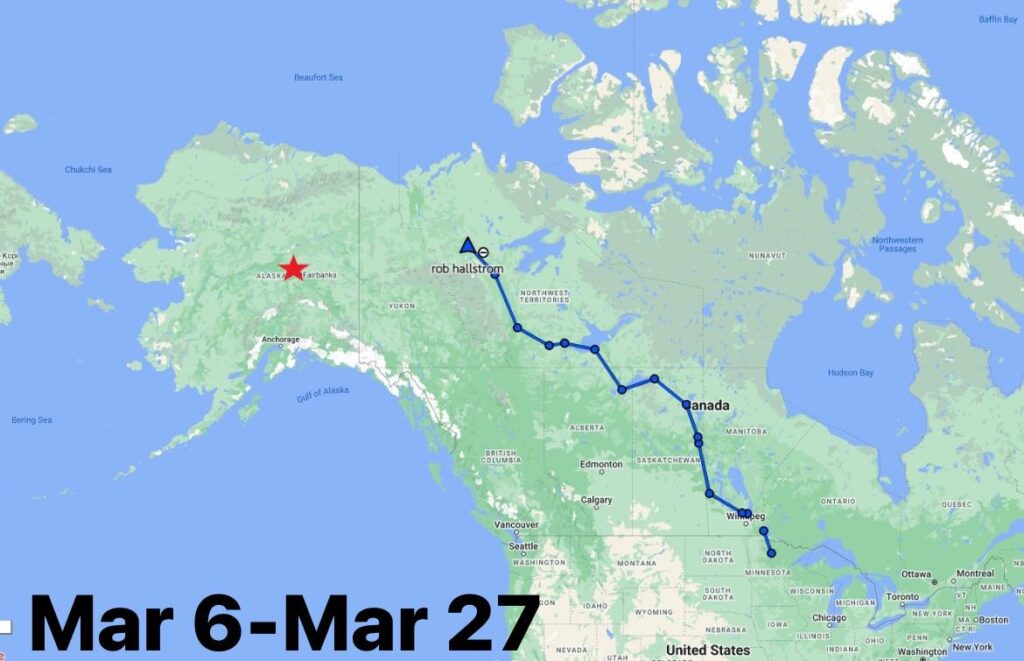
DAY 23/MARCH 28
The guys made it safely to the cabin they planned to stay in last night. We were able to get a short message via the GPS confirming their arrival; we understand a local intended to help escort them ~2/3 of the way and we are grateful for that generosity.
With GPS as the only means of communication last night, it brings up a question we have heard from many of you: “how are these 3 Old Guys supported?” ….
Tactically on the ground the 3 Old Guys greatest support is each other. With age comes wisdom and thankfully they have a lot of it! There is no “chase car” or crew within a reasonable distance available to help them if they were to need parts, repairs or emergency help. They leverage their smarts and the extra gear they’re hauling for anything they may need. The 3 Old Guys are also managing any modifications to their route in real-time on the ground. As we have noted, they do carry GPS devices and have SOS capability if a true emergency were to a occur and needed assistance contacting the nearest local authorities.
Critical to their success has been the support of the communities they travel through. The local towns and village support has been awe-inspiring. Not only have the communities welcomed them with genuine excitement, many have opened their homes offering warm meals, nourishment and intel for the journey ahead. In addition to this, these communities are where any extra supplies are obtained. Certainly gas, but we have already seen a couple locations where the guys have been able to access a shop or warm garage to do maintenance work. When the sled caught fire they were able to purchase a few make-shift supplies required to conduct the necessary repairs (and purchase a new fire extinguisher).
Back home is where all the “behind the scenes” action (if you can call it action) occurs. A group of roughly 10-12 people have access to their individual GPS trackers. These individuals make up family and close friends who can help support in a bind. Generally three things happen back home:
1) A subset of us watch their GPS trackers move across the screen all day as if it is a soap opera. We make predictions over group text of what is/is not occurring on the trail and quickly report in as soon as anyone gets confirmed updates that they have arrived, etc. – it is somewhat entertaining at times to think the guys are probably enjoying a rest on the trail and taking a picture, while back home we have a group chat going predicting the 50 things that could possibly be going wrong and “why are they not moving?!?!”
2) In the event there is an issue or a need on the trail, the guys are able to send a message via the GPS and, if we can help, we will. Two examples of this: when the sled started fire, back home we activated and started seeking parts for them while they were limping back to Flin Flon. By the time they got to town, we knew the 1-2 locations they would be able to get parts within 6 hours of Flin Flon. Thankfully, they were able to make it on their own and didn’t need the resources we had identified. Another example is when they struggled to find the trail heading into Southend during the storm. They sent a GPS message, we were able to DM a few locals and post to the Facebook community seeking help- within 10-15 minutes we had exact coordinates that we were able to GPS back to the Guys.
3) Updating Facebook! Clearly, 99% of the time the guys are focused on the trail and preparing for the next day on the trail. They have had limited time to effectively update Facebook, so we do our best to translate their whereabouts and share back what they tell us from quick calls home. Whenever possible they pop on themselves and give “trail reports”. Facebook is primarily managed by me, Rob Hallstrom’s daughter, Kasie Plekkenpol, from my Minneapolis, Minnesota home. Rob’s wife (and my beautiful mother), MaJeana, drops in as well here and there, generally to help reply to comments. And often you will see other posts and comments from Paul and Rex’s wives, family and friends – though those are done from their personal Facebook accounts.
This brings me to another key area of support- all of you! We have been overwhelmed by the following and support on Facebook and we are beyond thankful. This has been a critical tool to helping obtain additional insights about trail conditions, cabin availability, and any other help we have needed in a pinch. According to Facebook, we have followers from the US, Canada, Sweden, Norway, Iceland, Finland, Nigeria, France and Ghana. When the guys get in at night after a long day and have service, they often take a few minutes to check these updates – your encouragement, comments and positivity brings them momentum for the trail. Thank you. Thank you. Thank you. My dad, Rob, has commented multiple times about how much he looks forward to reading through every comment and post and replying back to all of you when he is back home sipping his coffee re-living the moments he is experiencing now.
Last, but certainly not least, our sponsors. While the trip is 96% funded by the 3 Old Guys, they were able to obtain a few sponsors. Arctic Cat has stepped up in a big way helping with discounts on the sleds, parts, and return shipping – and as they have been watching the beating these guys have been doing to the machines (gravel roads, much?), have shipped some parts ahead of the guys in the event they need anything swapped out- huge thanks to Arctic Cat!
Klim provided gear to keep them safe and warm and C-tec2 provided oil. They also received parts for the trek from Woody’s, Rok Straps, and Straightline Performance. Further, after so many of you asked how you could help, we spun up a buymeacoffee site for those that were inclined to pitch in on a meal or gas – which given the fact that this trip is taking an extra 7-10 days longer than anticipated, has been extraordinarily generous and helpful- so thank YOU for your sponsorship as well!
So, while the 3 Old Guys are on the sleds enduring the weather, terrain and challenges of the day – leaning on one another for day-to-day survival, they certainly are not alone.
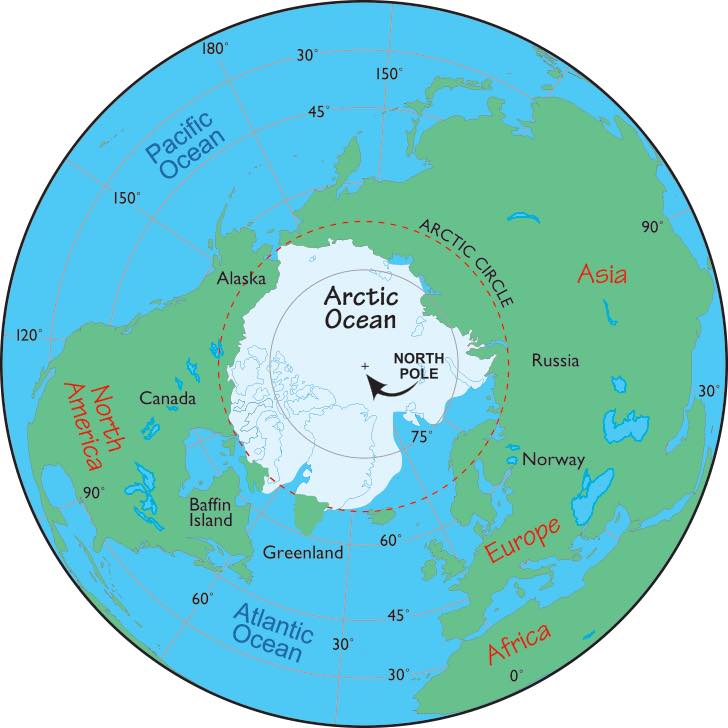
The 3 Old Guys have officially crossed the Arctic Circle!
For those that are not familiar, the Arctic Circle is an imaginary line defined by where the sun does not completely set for the Summer Solstice (June 21) and never rises on the Winter Solstice (December 22). Everything north of the line is considered the Arctic.
A few facts about the Arctic:
-8 countries own land within the Arctic Circle: United States, Canada, Russia, Norway, Finland, Sweden, and Greenland
-The Arctic landscape is made up of glaciers, icebergs, sea ice and permafrost (soil and rock that remains frozen for years at a time)
-Average air temperatures above the Arctic Circle are around -30F in winter
-60% of the world’s polar bear population are found in the Canadian Arctic
-One fascinating species found only in the Arctic is the narwhal, 75% of that population is found in the Canadian Arctic
-The word ‘Arctic’ comes from the Greek word for bear, Arktos. But this isn’t because of the polar bears! It’s believed the name refers to two constellations that can be seen in the northern sky — ‘Ursa Minor’ (Little Bear) and ‘Ursa Major’ (Great Bear)
DAY 24/ MARCH 29
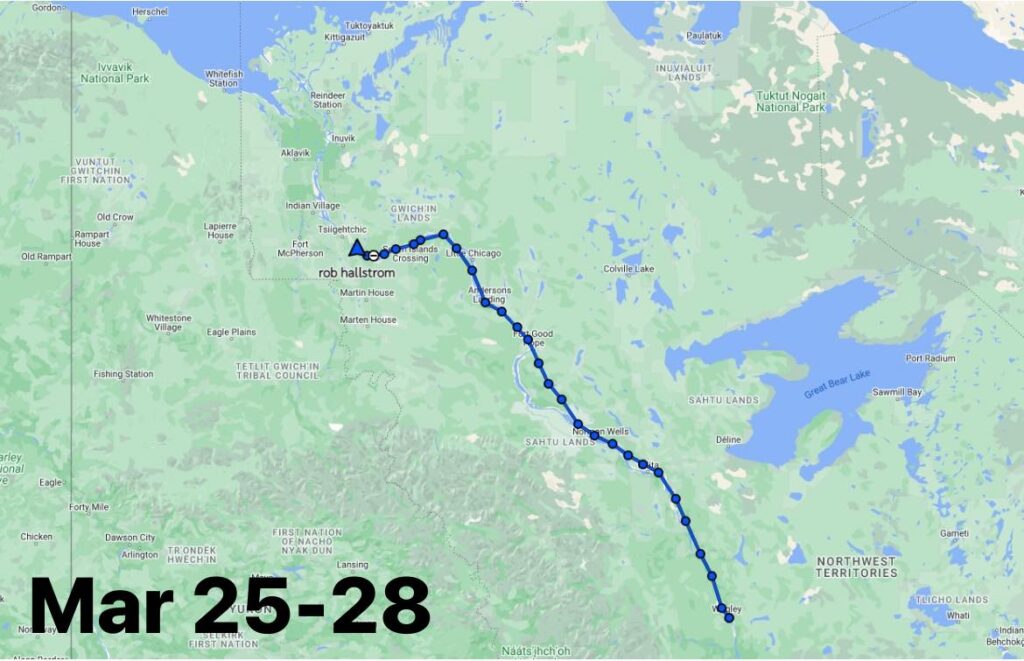
Last night the 3 Old Guys were able to stay in a cabin just South of Tsiigehtchic arriving in perfect time as a small blizzard started coming through. Thanks to Shawn Van Loon for the hospitality and letting us know when the 3 Old Guys passed through Tsiigehtchic today. They are now headed towards Inuvik down the Mackenzie.
Formerly called Arctic Red River, the community officially changed its name to Tsiigehtchic (Mouth of Iron River) in 1994 to honor its traditional name. Tsiigehtchic is a community of just under 200 people located at the scenic convergence of the Arctic Red and Mackenzie Rivers.
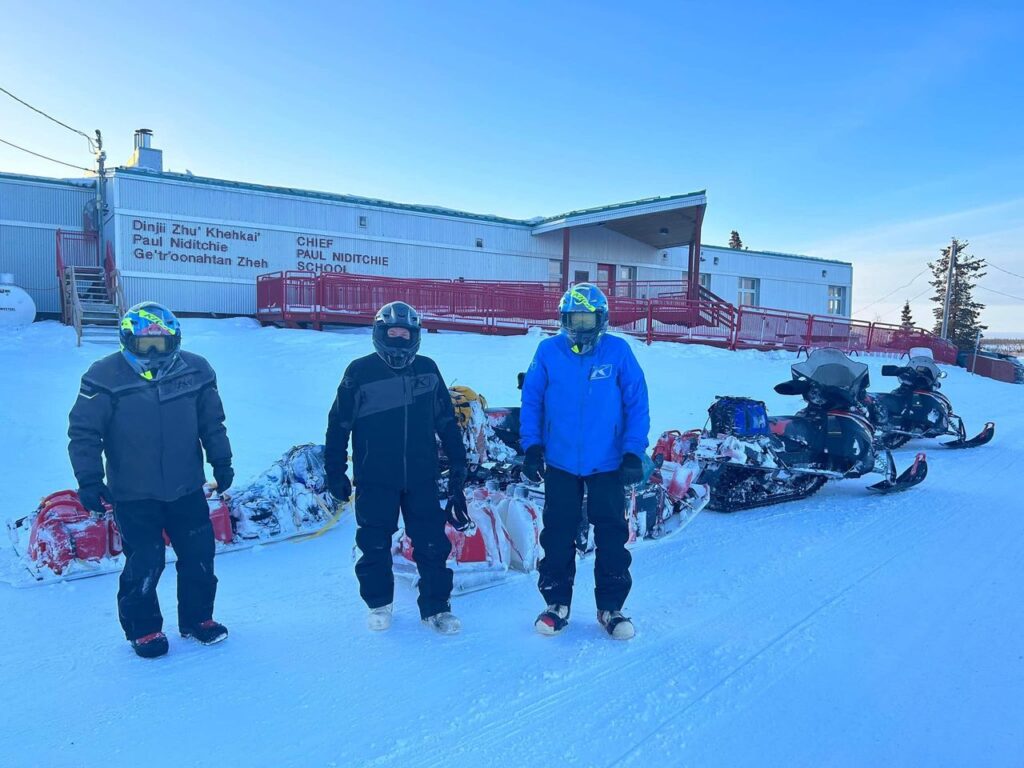
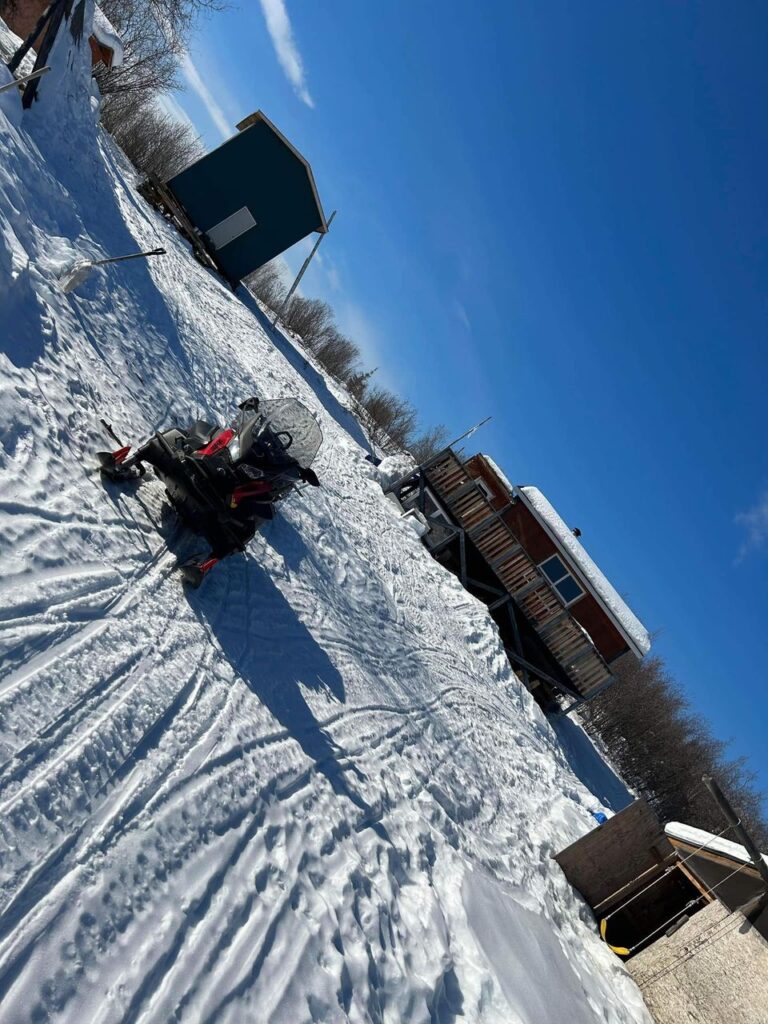
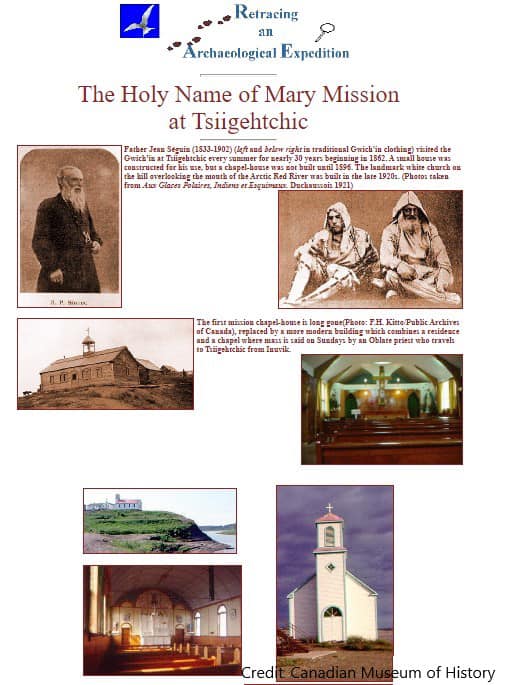
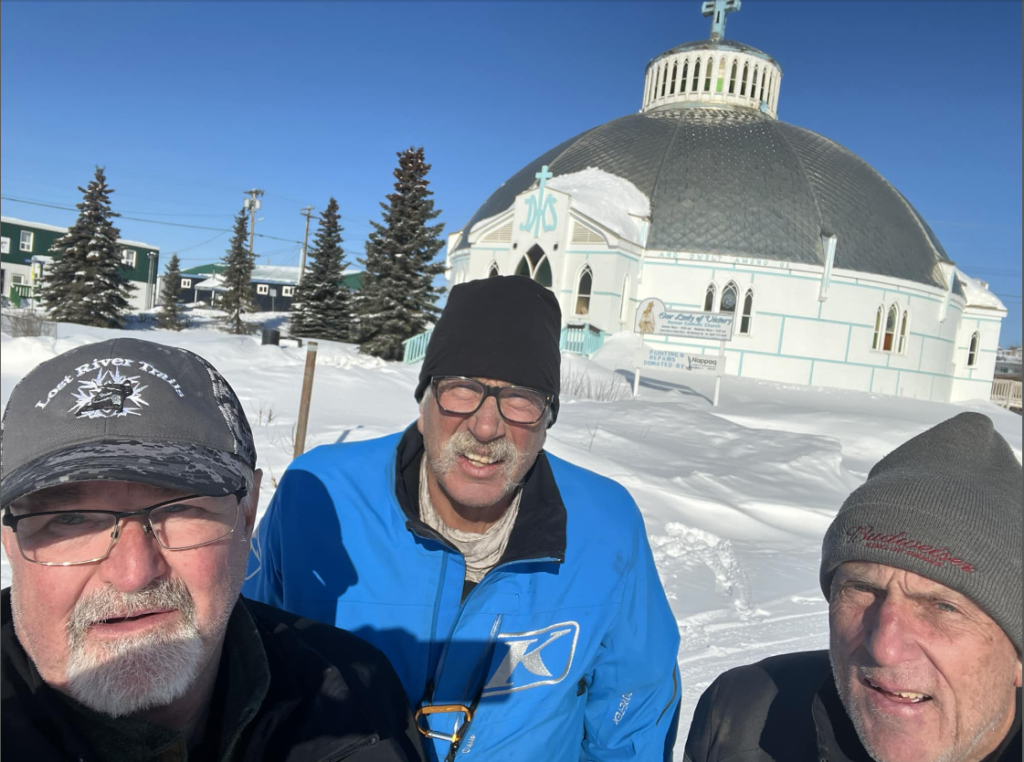
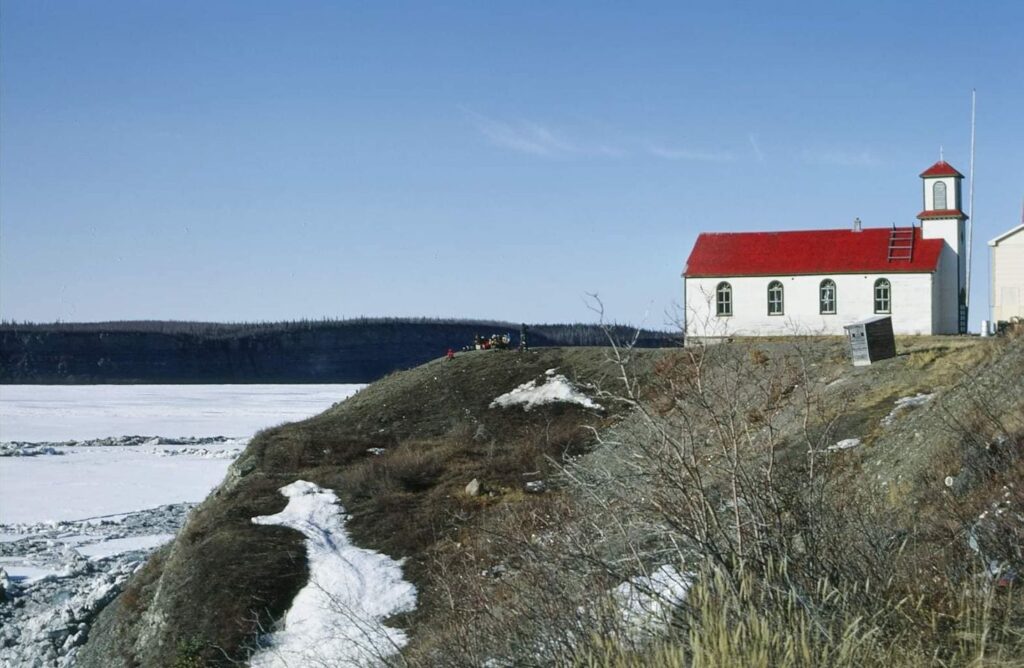
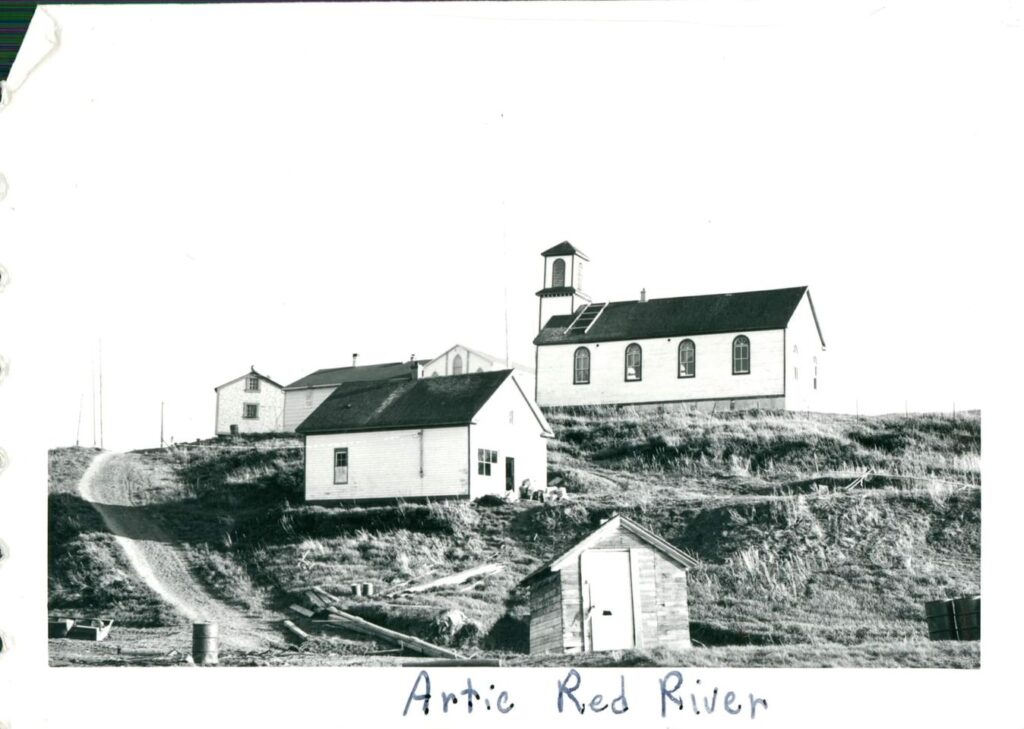
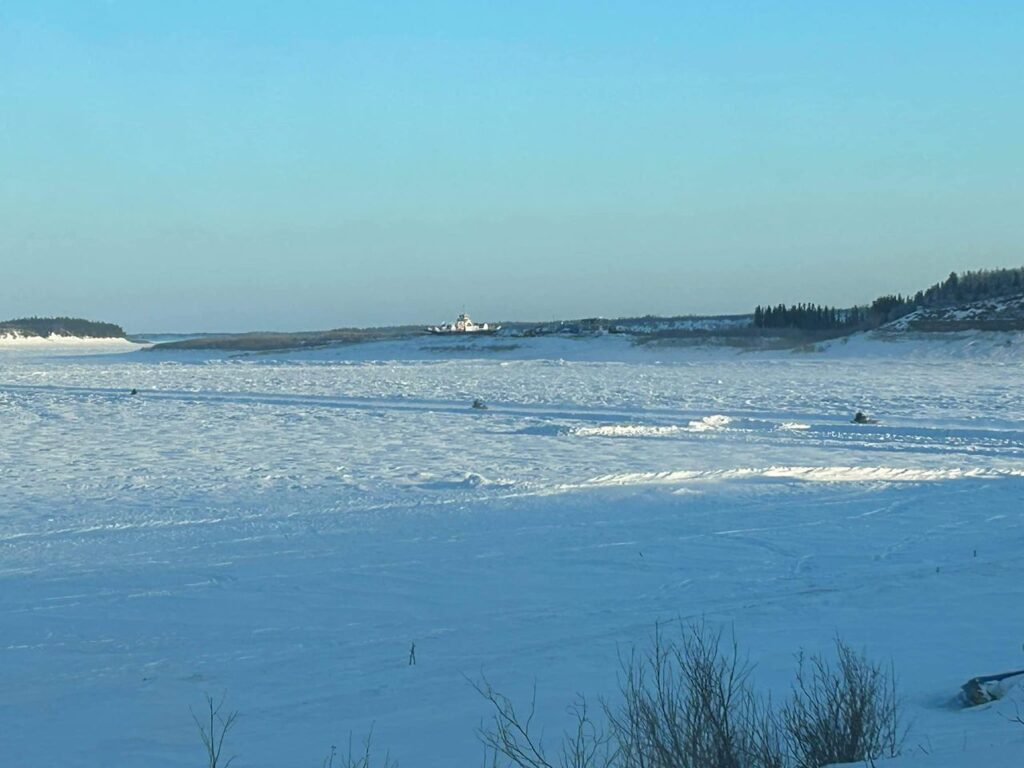
This location has a long history as a summer fish camp for the Gwichya Gwich’in people. As long as anyone can remember, the Gwichya Gwich’in traveled up the Arctic Red River into the mountains along the Yukon NWT border, in late summer. There they lived and hunted through the winter. When the river opened in spring, they returned to their fishing grounds at Tsiigehtchic and other places along the Mackenzie River for the summer. Permanent settlement here began with the establishment of a Catholic mission in 1868, followed by a Hudson’s Bay Company trading post in the 1870s.
Many of Tsiigehtchic’s Gwich’in residents still remain close to the land today. You can see net fishing year-round, as well as view the traditional methods of making dryfish and drymeat. In the winter, trappers are busy in the bush hunting animals for meat and fur.
Reference: GTC Department of Cultural Heritage and Spectacular Northwest Territories
Guys have arrived safely in Inuvik. They’ve made it 3,100 miles towards their final destination. 3/4 of the way there!
Left to right: Rob, Rex, Paul
Trail report – Got in to Inuvik today and are taking a much needed rest. The mighty Mackenzie is an amazing river. Big wild and remote! We had a little of everything that really tested our skills Good planning and a healthy dose of luck had us in a cabin the last two nights. There are a few cabins with in 20 or 30 miles of towns but other than that it’s pretty lonely country out there. We were close to breaking out the tent when we found one last night. The cabin meant a comfortable night and the fact that we were coming back out of the wilderness and approaching people again. It had been about 135 miles with out a sign of people. Sleds have been doing great. Old guys tired but feeling good. Front of my sleigh need some work but it happened right in front of the first cabin, how lucky can we be!
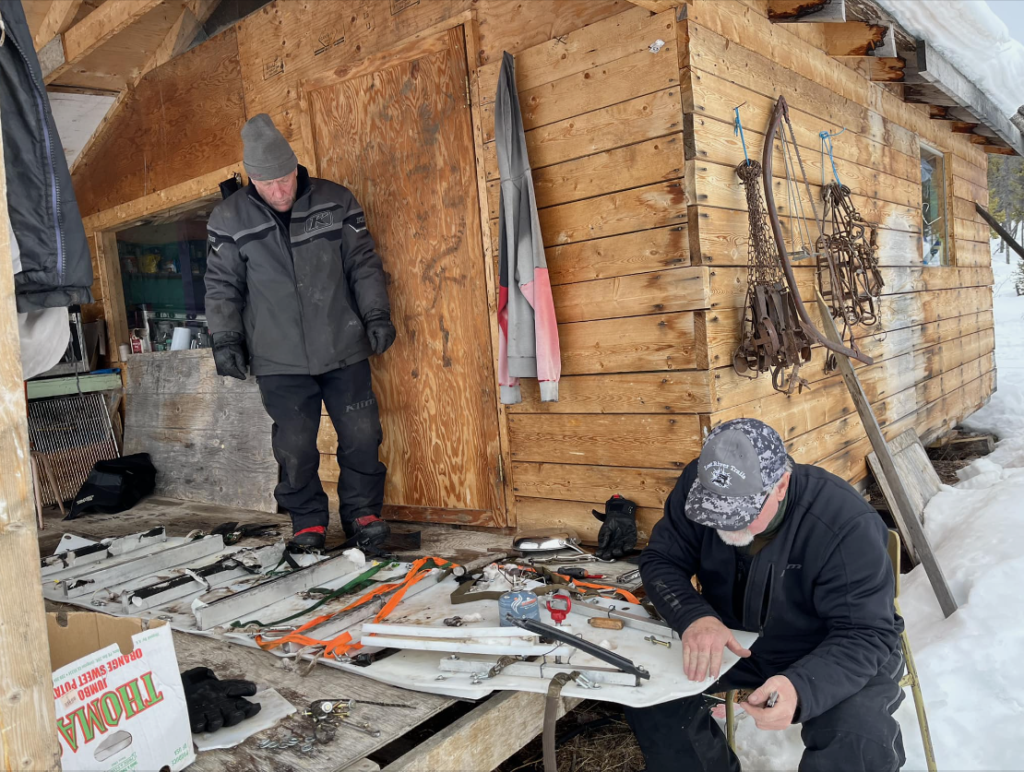
Paul, left. Rob working on sled.
DAY 25 / MARCH 30
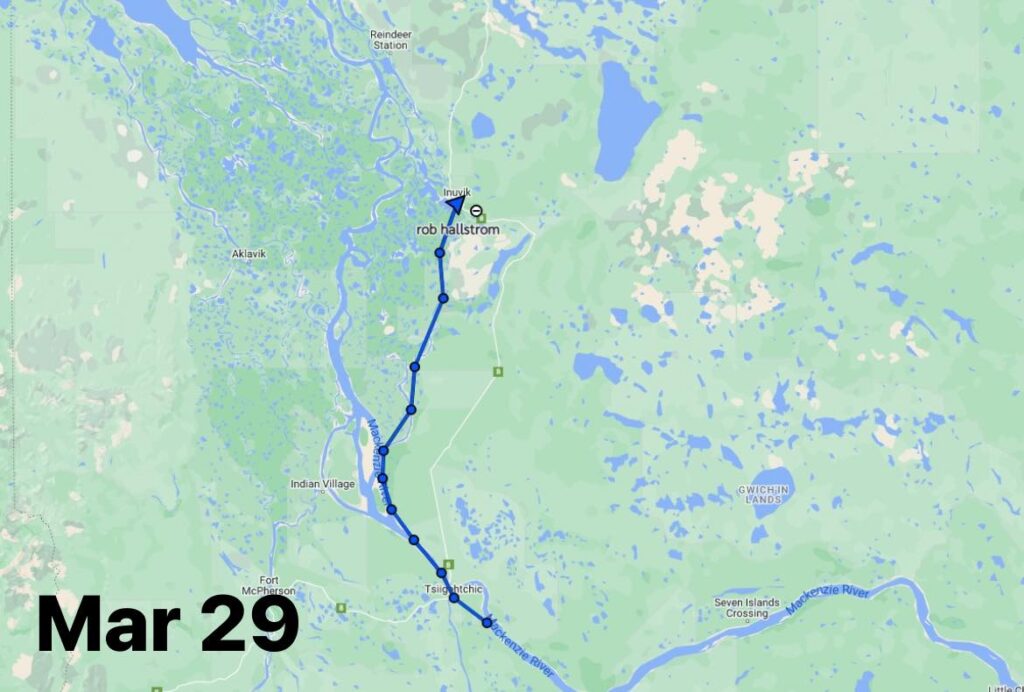
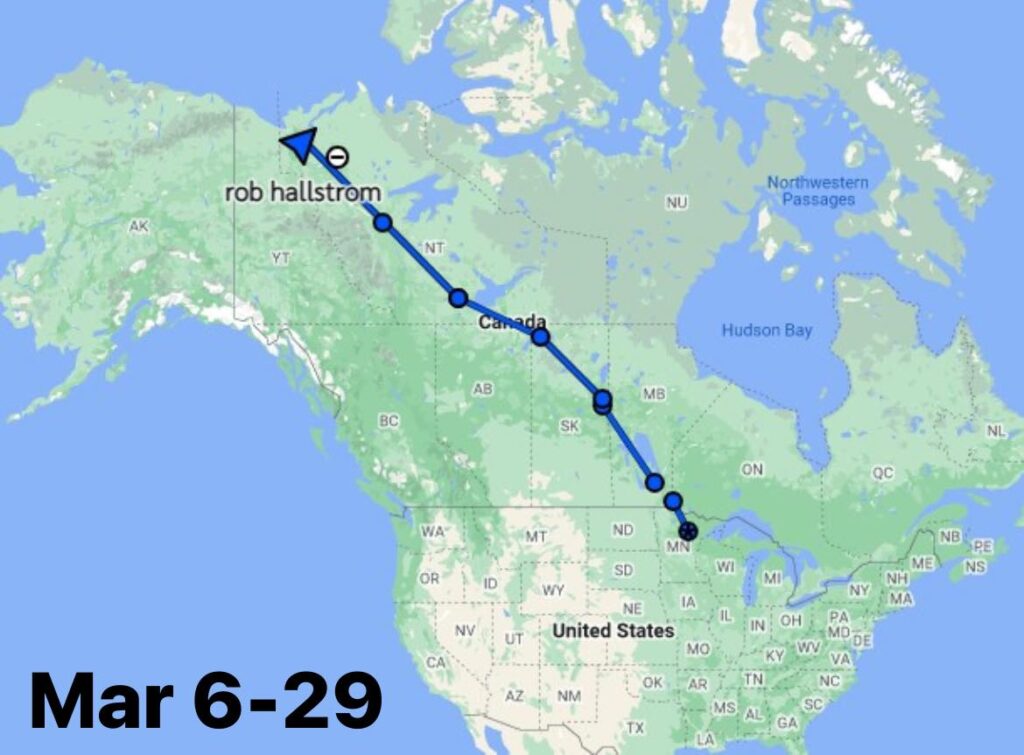
Anybody that thinks this ride has been a stroll in the park for these 3 Old Guys would certainly be wrong! Our Guys are having fun, and they are living their best life, but they are working for it. Today is a “rest” day, but there is little rest taking place. The day has been filled with maintenance and – hopefully – a full meal here and there. Thankfully, they are in a great city, Inuvik.
According to an address by T. Detlor, Aurora Campus Arctic College from July of 1989 the Town of Inuvik’s history is quite short but it’s not without excitement.
The area, traditionally for the native people was really no-man’s land between the Inuit to the north and the Dene to the south. Only the odd trapper ever visited the site of Inuvik. During the mid 1950’s the government of Canada felt there was a need for an administrative center in the Western Arctic. Aklavik, the traditional center was subject to flooding and erosion, in fact experts of the day felt Aklavik would be washed into the Mackenzie before too long. As well there was insufficient space for the needed expansion. Consequently, a search for a new site was launched.
In 1954, the first survey teams flew to the Mackenzie Delta, looking for the best site for the future, but unnamed town. A number of potential sites were identified with this location being referred to as East Three. The site was on a navigable river with access to wood, gravel, a good, clean water supply and enough flat land for a major airport. Moreover, the site had plenty of room for expansion and definitely with no flood concerns. The East Three site was selected and in hindsight the choice was a good one.
The planning and construction of Inuvik was completely new. A venture like this had never been tried in Canada thus every stage of the development became a pilot study, an experiment, a new experience. Building a town from scratch, on the permafrost, in the Arctic was a major undertaking.
The site was chosen in November 1954 and construction began in 1955 with completion scheduled for 1961 or 1962. Construction was not an easy task. The presence of permafrost meant building had to be on piles, and above ground utilidors for water and sewer were needed. As you walk around town you’ll notice little shed like structures running between buildings. These are utilidors.
To give you some idea of the complexity of building Inuvik consider that every building, every road, every structure, the entire airport, everything had to be either on piles or on a three foot gravel pad. The runway at the airport is 6000 feet long and its entire length including the taxiways are on a gravel pad, in some areas the pad is 6 feet thick.
In the area where Inuvik is built there is a lot of ice lenses. This is frozen groundwater. In some places where the water has collected there is pure ice. Blue ice. This is the reason the book about Inuvik is called “On Blue Ice”, we really built on blue ice. If the ground gets heated and the ice melts there is no structural support and the land will collapse. This can be quite dramatic. Once, a fifty foot wide section of road beside the sewage lagoon suddenly dropped about 25 feet as the ice dense beneath was heated by the lagoon and the ice melted, down went the road. The permafrost must be protected.
Construction continued with the building of the school in 1959, and the hospital, office buildings and staff housing in 1960. The RCMP, CPC, NCPC, Transport, National Defense, National Health and Welfare, Citizenship and Immigration all has personnel living in Inuvik. Many of the first houses built were cabins 16 ft by 32 ft and because they contained 512 sq. ft. they became known as 512’s.
During the early days the community grew rapidly as Inuvialuit, Dene and Metis from the Delta/Coast region and people from southern Canada moved to Inuvik, creating a unique three culture community.
Oil was discovered in 1970 with natural gas being found in 1971 in the Mackenzie Delta. These discoveries lead to further expansion of Inuvik. The major oil companies established offices in town and the service sector for the oil patch rapidly expanded. Scientific and environmental research in the area also expanded and the Federal Government opened a scientific research laboratory in Inuvik.
By 1970, Inuvik had grown-up and in January 1970 became Canada’s first and only Town north of the Arctic Circle. The first Mayor was Richard Hill. During the early 1970 Inuvik was a flourish of activity. Buildings were being constructed, subdivision were established all in the anticipation of the production of oil and gas from the Delta. However, things came to thundering crash in 1977 as a result of a 10 year moratorium recommended by Justice Berger. Inuvik quickly learned what the term boom-bust means. The downturn was halted and by 1980 with the renewed interest in oil offshore the town started to grow again.
This renewed growth was short-lived. In May 1985 the Government of Canada announced that they were closing the Canadian Forces base in Inuvik. The base was staffed by 267 personnel and at that time was the largest single military installation in the North. The closing of the base meant that about 700 people left town. The Town felt that the military had made a mistake. Inuvik is in a very strategic location. If you look on a map you can see that Inuvik is on the Northwest entrance into North America and the western entrance to the Northwest Passage. We lobbied the military and the politicians pointing out the value of Inuvik. As a result, Inuvik was named as a Forward Operating Location for the F18’s and we are the resupply base for the western portion of the North Warning System.
It is not all doom and gloom. Today Inuvik is still the regional government centre and the transportation hub of the Western Arctic. The completion of the Dempster Highway in 1979 opened Inuvik and the Western Arctic to the people of the world. Tourism is one of the growth industries in Inuvik now.
DAY 26 / MARCH 31
The 3 Old Guys had a full day yesterday! They spent the bulk of their day conducting maintenance on the sleds and proactively swapping parts that had been taking a beating on their trek. As the day was winding down the 3 Old Guys were blessed again by new friends and had the opportunity to ride up to Tuktoyaktuk via truck to fulfill their desire of seeing the Arctic Ocean on this journey. Tuk is the only place on the Arctic Ocean connected to the rest of Canada by road.
While it made for another long evening, the Guys were extraordinarily grateful to see Tuk, enjoy the company of a new local friend, and save their sleds and backs from riding through the “wide open country past the tree line” 100+ miles each way.
Today, they set out towards Fort McPherson hoping to see the “Mad Trappers” grave site.
For those unfamiliar with the Mad Trapper of Rat River, this is a true story of Canada’s biggest manhunt and could easily be considered on par with Bonnie and Clyde and John Dillinger. Here is a teaser from the Canadian Encyclopedia, but I highly encourage you to follow the link or dig into the book for the full story- this is one that can’t possibly be summarized in a Facebook post!
“Albert Johnson, also known as the “Mad Trapper,” outlaw (born circa 1890–1900, place of birth unknown; died 17 February 1932 in Yukon). On 31 December 1931, an RCMP constable investigating a complaint about traplines was shot and seriously wounded by a trapper living west of Fort McPherson, NT. The ensuing manhunt — one of the largest in Canadian history — lasted 48 days and covered 240 km (150 mi) in temperatures averaging -40°C. Before it was over, a second policeman was badly wounded and another killed. The killer, tentatively but never positively identified as Albert Johnson, was so skilled at survival that the police had to employ bush pilot Wilfrid “Wop” May to track him. The Trapper’s extraordinary flight from the police across sub-Arctic terrain in the dead of winter captured the attention of the nation and earned him the title “The Mad Trapper of Rat River.” No motive for Johnson’s crimes has ever been established, and his identity remains a mystery. “
Recommend the book: The Mad Trapper of Rat River: A True Story of Canada’s Biggest Manhunt by Dick North
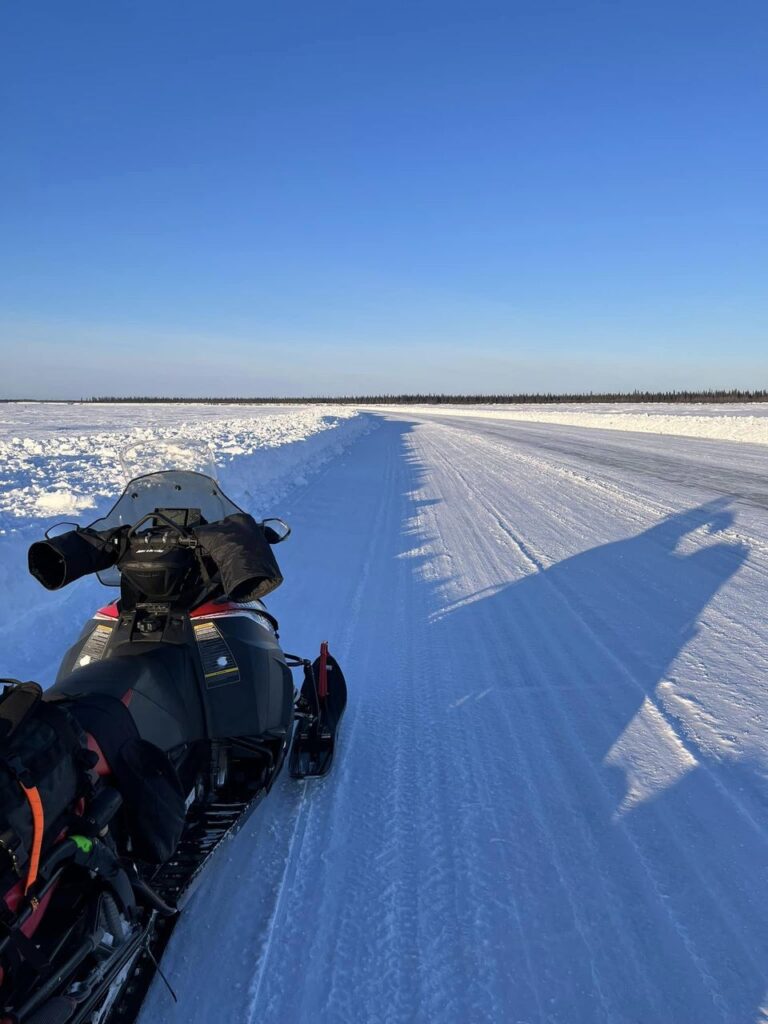
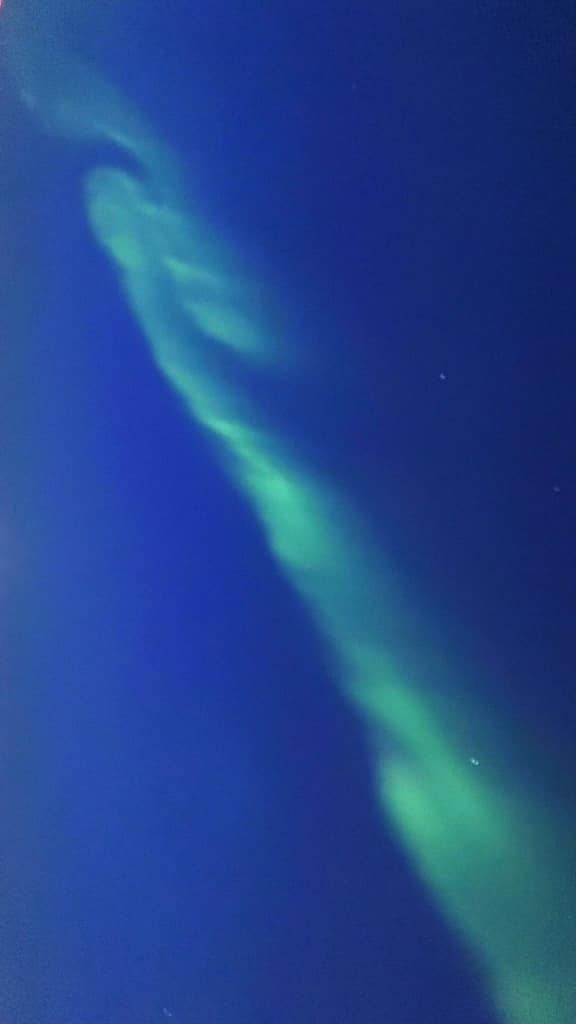
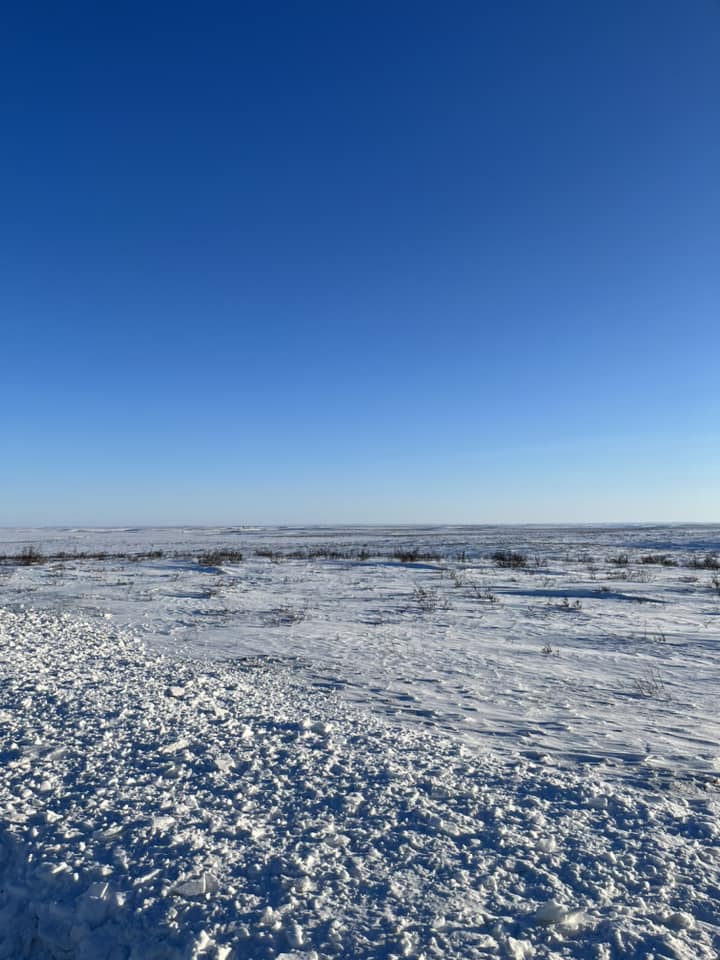
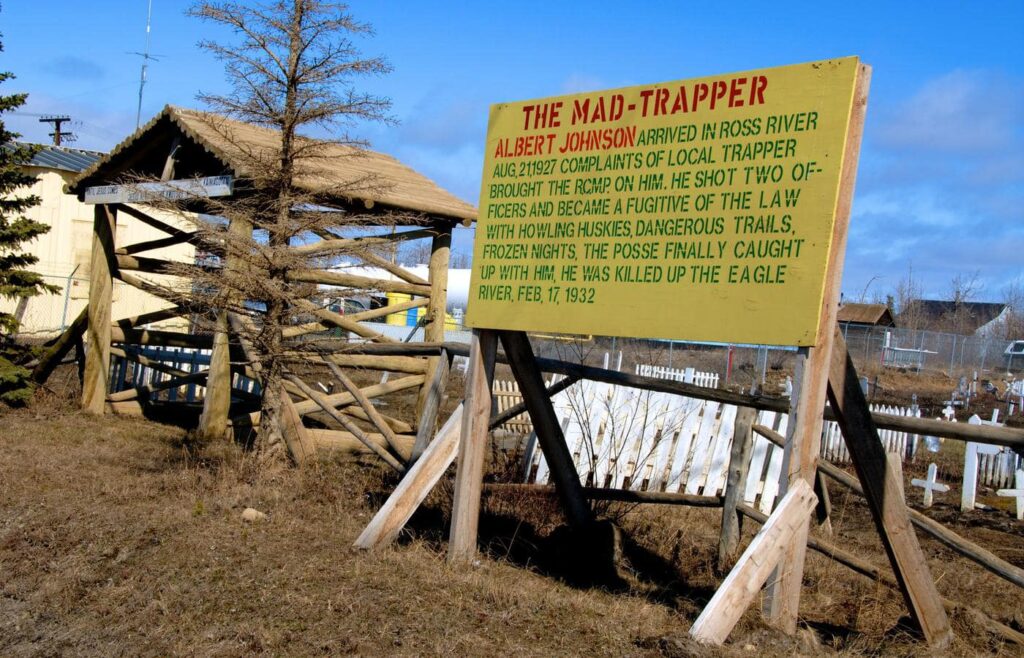
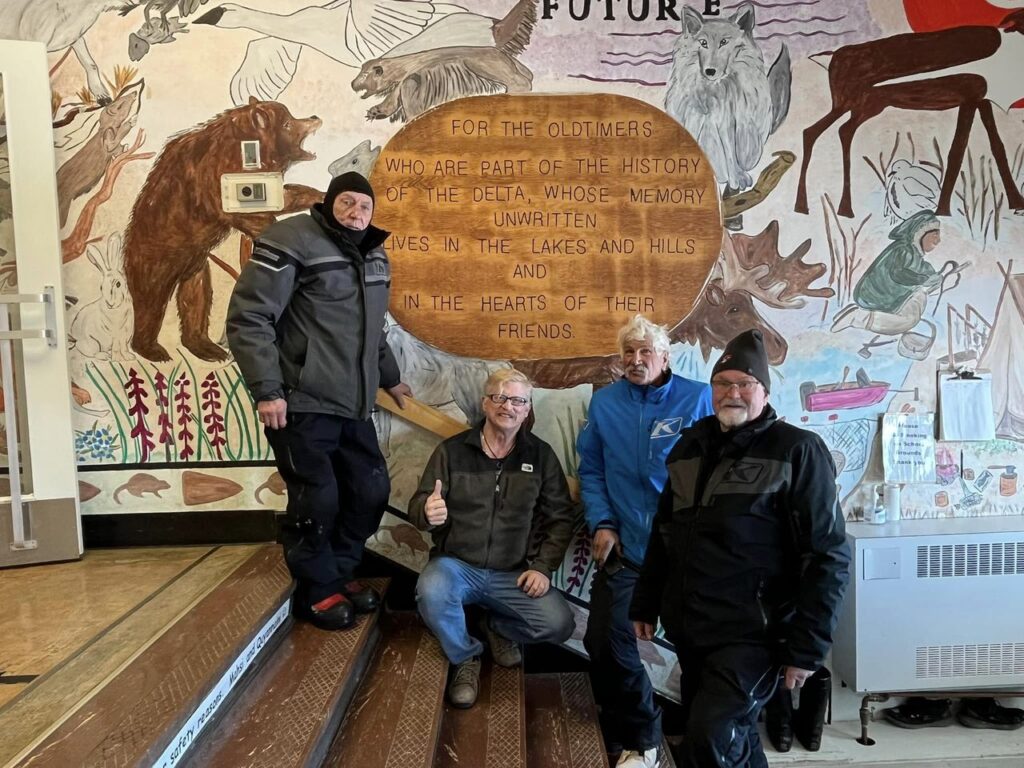
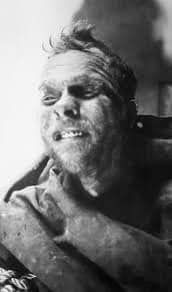
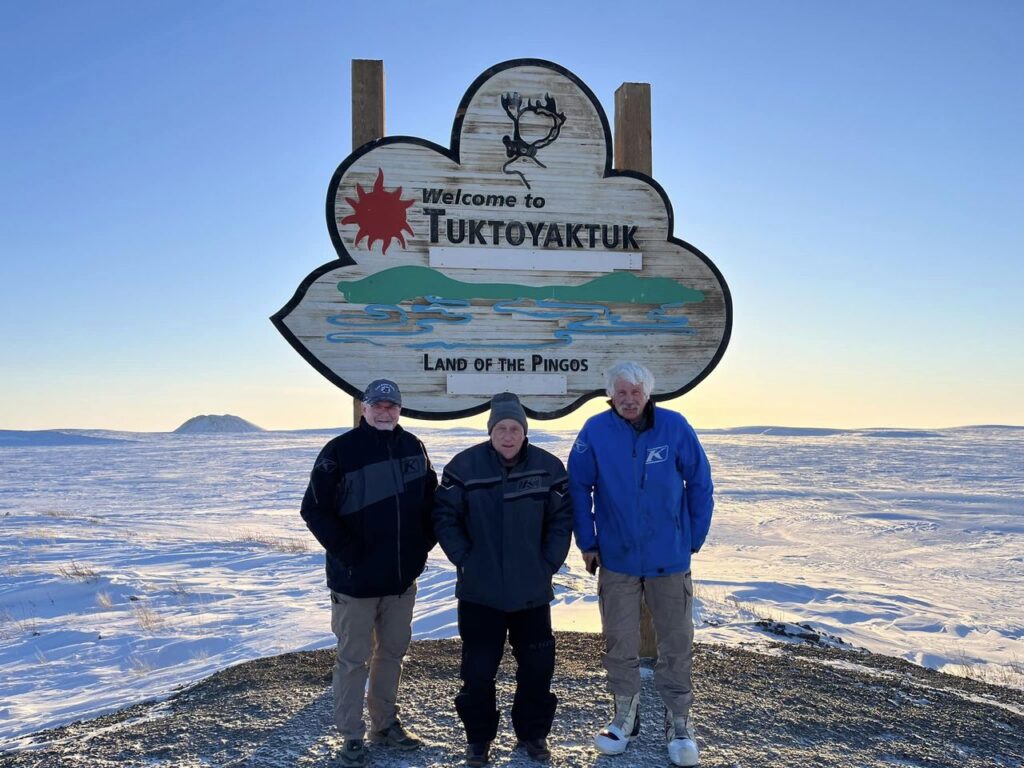
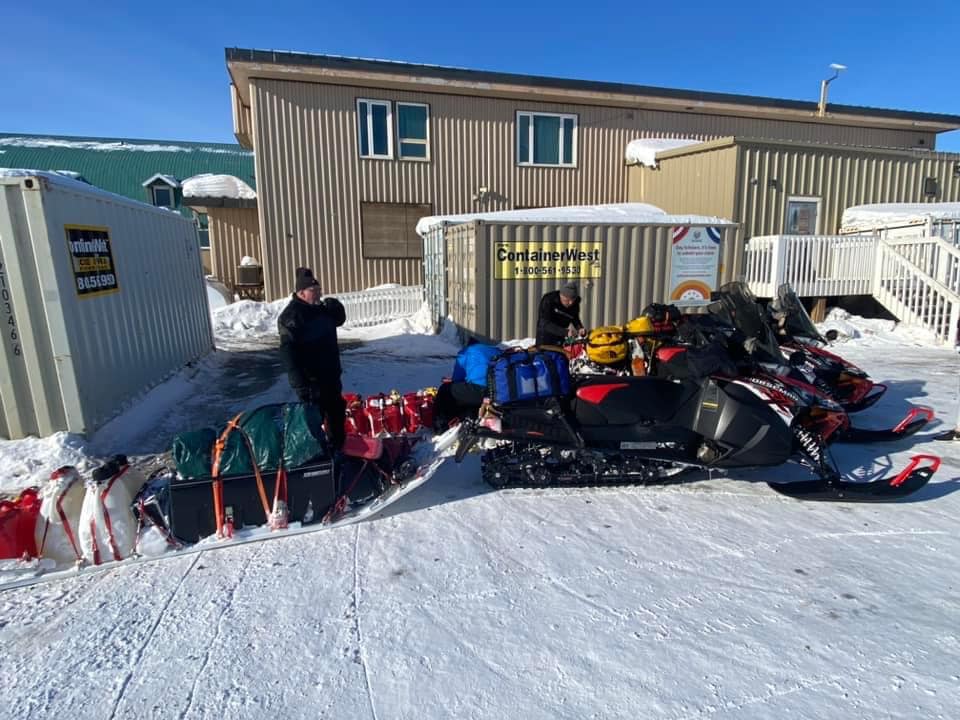
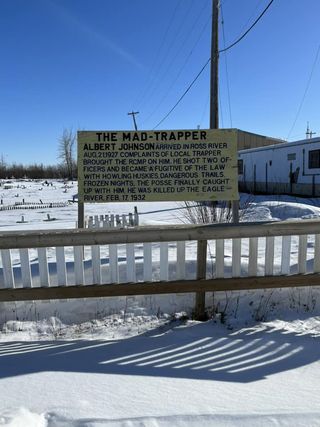
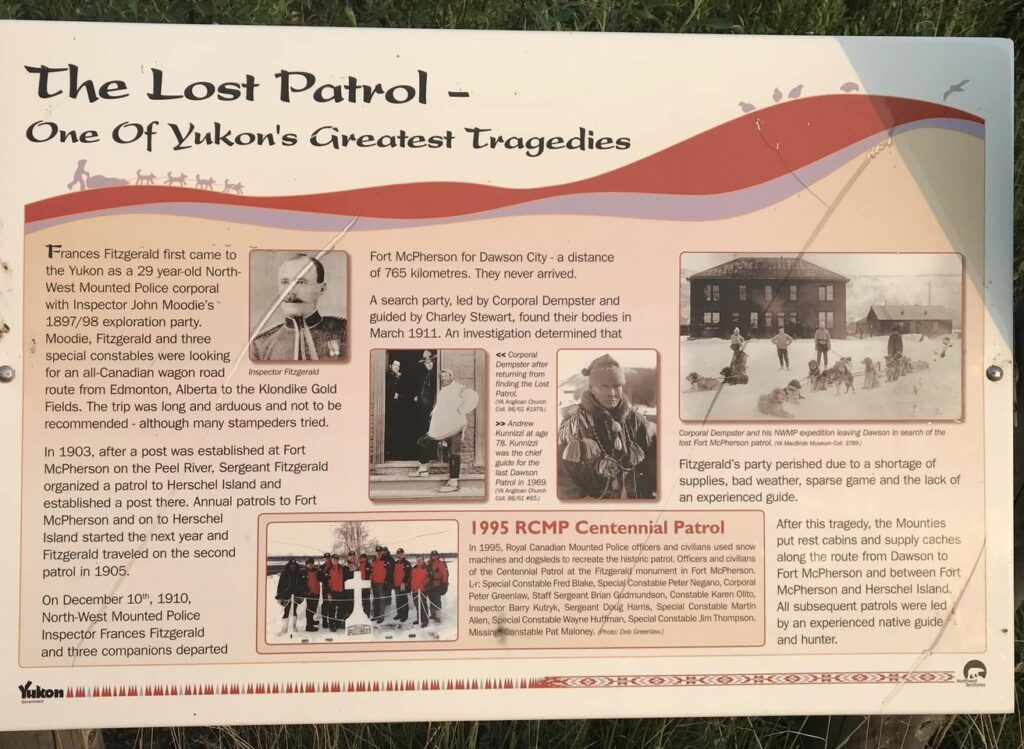
Evening Update – The Guys had a successful day riding from Inuvik to Fort McPherson, with a stop in Aklavik along the way. Upon arrival in Fort McPherson they found the only hotel in town under renovation. “Everyday a new adventure.” Thankfully, there have been such great people on this trail, and we have confirmation they have secured rooms for the night- no more details to report on that for now.
As is standard on this “trail,” Fort McPherson is rich in history. In 1905, the Royal Northwest Mounted Police (NWMP) began a yearly winter patrol of approx 550 miles over the toughest, coldest terrain in Canada from Dawson City, Yukon to Fort McPherson, NWT to deliver mail and dispatches. These patrols, though very tough on men and dogs, went without incident until 1911. The patrol that year was asked instead to be made from Fort McPherson to Dawson.
Led by Inspector Fitzgerald, with Constables Kinney, Taylor and ex-Constable Sam Carter. They began the their journey from Fort McPherson to Dawson on December 21, 1910, but they never made it to Dawson. The trip became known as “The Lost Patrol.”
They had three dog-teams, totaling 15 dogs and provisions to last about a month. Somewhere around the Little Wind and Hart rivers, they lost their way. The winter conditions were severe and their rations were getting low. The attempt back to McPherson proved to be difficult. Weak from lack of food and exhaustion, the team were able to walk only a few miles a day- perhaps not at all some days.
They began to kill the dogs one by one for food. With all the dogs dead, they began to boil their buckskin thongs and dog harnesses.
Within 35 miles of Fort McPherson, Kinney and Taylor could go no further. Fitzgerald and Carter carried on. Within 25 miles of the village, Carter, unable to continue, died. Fitzgerald made it only a few hundred yards more before he too lay down and waited for death. February 5, 1911, day 47 of this fatal patrol, was the date of the last entry in Inspector Fitzgerald’s diary.
In February, when the party failed to arrive in Dawson, Corporal Dempster, along with three Constables and an Indian guide, were ordered to begin a search. On March 21, 1911, after nearly a month of searching, the lost patrol was found.
Patrols were still made annually until 1921, but because of the fatal trip of 1910-11, a number of measures were taken to ensure that this tragedy never occurred again. Future patrols always hired an aboriginal guide. Cabins and regular caches were established along the trail in case of food shortages. Most importantly, the Forrest Creek Trail was clearly marked so that it would not be missed again. These measures proved successful.
All four men are buried at Fort McPherson along with a memorial to the NWMP of 1910.
Reference: Royal Canadian Mounted Police, and Les McLaughlin, Yukon Nuggets
DAY 27 / APRIL 1
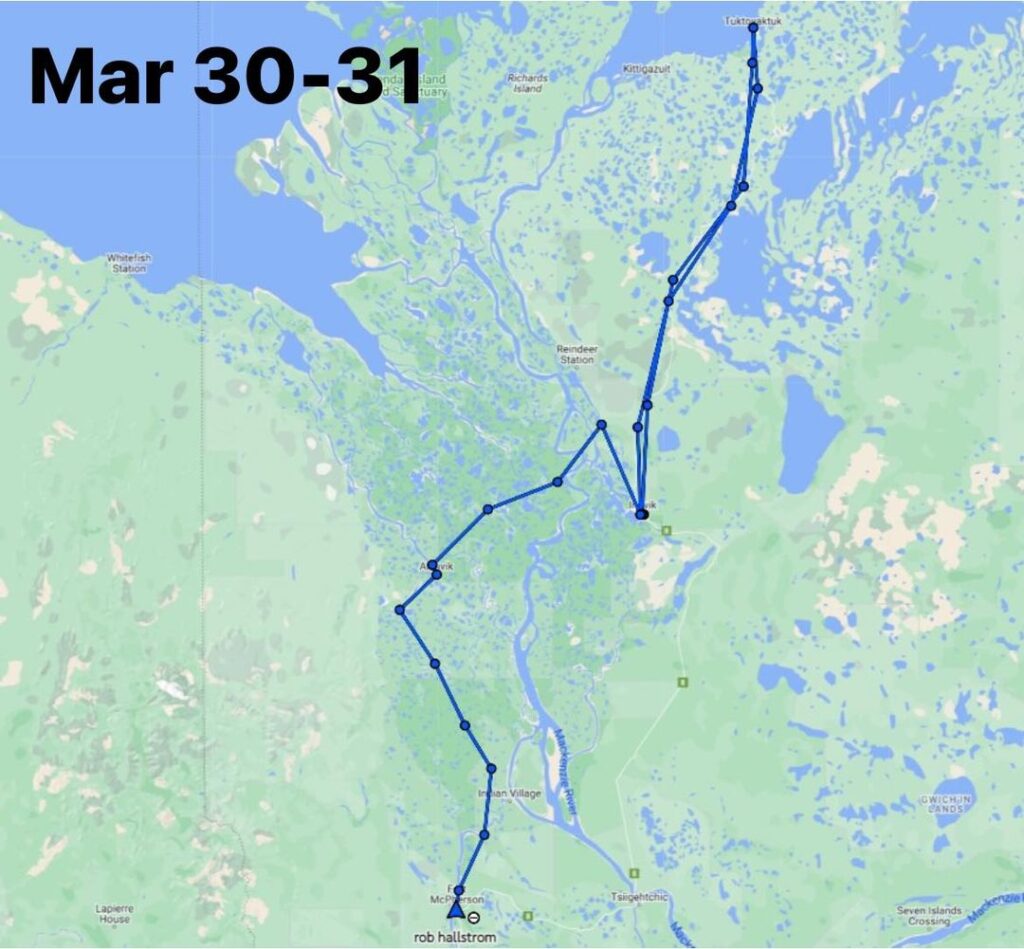
Despite being an unbelievable ~3,500 miles in (not odometer actuals), with only ~700 miles to go, the 3 Old Guys will not be fooled today. They know they are gearing up for some of the most challenging part of their route as they leave Fort McPherson this morning toward Old Crow via the Richardson Mountains.
The Richardson Mountains parallel the northernmost part of the boundary between the Yukon and the Northwest Territories, representing the northern extremity of the Rockies. To further give you a sense of the remoteness of this area, Old Crow, their destination, is only reachable by winter road – a winter road that is only made every other year or so.
The route they intend to take today is an old dog sled trail that holds deep history among the Gwich’in, this trail connected the communities together, but in the late 70s almost all use had ceased. In an effort to retain their important history, the late Chief Johnny D. Charlie made the trek again in the 1990s starting an important tradition. Prior to the 3 Old Guys departure they heard there would be a group making the trip this year (something that happens every few years or so if understood correctly) in honor of Johnny D. Charlie; this excursion happened a few weeks ago. The Guys are hoping they will be fortunate enough to follow in their tracks per say, but in this area with snow and wind conditions as they are it could be hard to 1) find the trail and 2) while they may be fortunate to find and follow their route, there may not be any actual tracks left. It continues to be an honor for these 3 Old Guys to travel the land that embodies such deep and important history.
DAY 28 / APRIL 2
No day is an easy one. Yesterday, April 1, the Guys got an early start with two plans: Plan A was to find the “Johnny D. Charlie” trail and cover a lot of miles riding a full, long day all the way into Old Crow; Plan B was to cabin halfway along the trek.
As they’ve said from Day 1, there always has to be a Plan C, D and so on….
The Guys departed and quickly realized they were headed the wrong way. They turned back covering most their tracks back to Fort McPherson before going South in search of the correct trail. And then…. Something broke on Rob’s toboggan. They were still relatively near Fort McPherson so they opted to head into town to conduct the necessary repairs. Those of us at home watched their GPS pings with bated breath as the hours ticked by and it rolled into afternoon thinking perhaps they would stay the night and try again come morning. We should have known better- the 3 Old Guys probably saw the first half of their day as a pre-game and soon they were back on their sleds riding again.
While this is not confirmed, we believe they got a bit more intel on the trail when they went back to town and were able to more easily navigate to the correct route on Round 2.
Intel from Fort McPherson locals may be true, or not, but once en route and down trail a good way they still struggled to find the right path, ultimately making the decision to end their day in one of the first cabins on the trail.
Whether Plan D, E or F – it was a long day, but as always, the Old Guys remain nimble, and knowing they’re “so close to trail,” they are optimistic to conquer today with fresh eyes.
The guys successfully found the trail today, but whiteout conditions prohibited them from moving forward and they retreated back to the cabin they stayed in last night to safely wait out the weather. Fingers crossed for good weather and happy trails tomorrow. Third time is the charm?
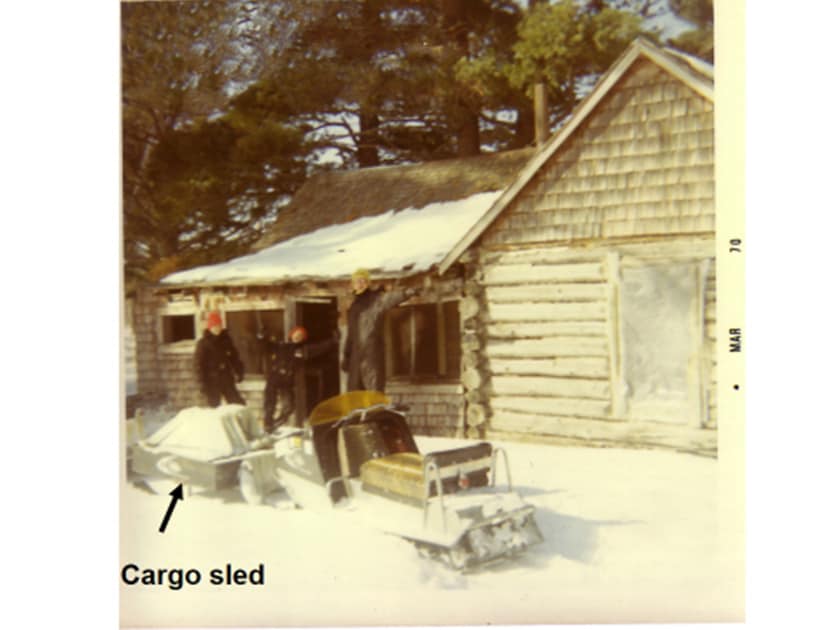
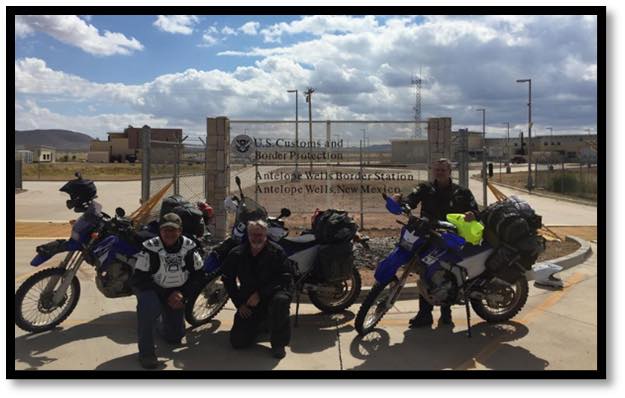
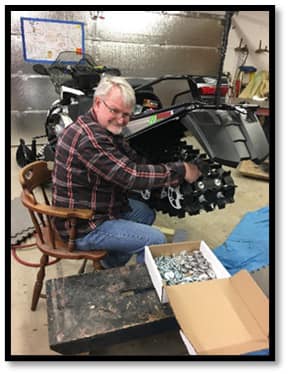
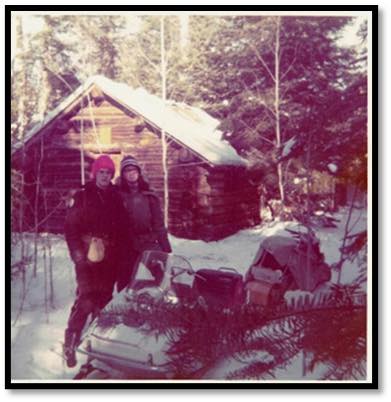
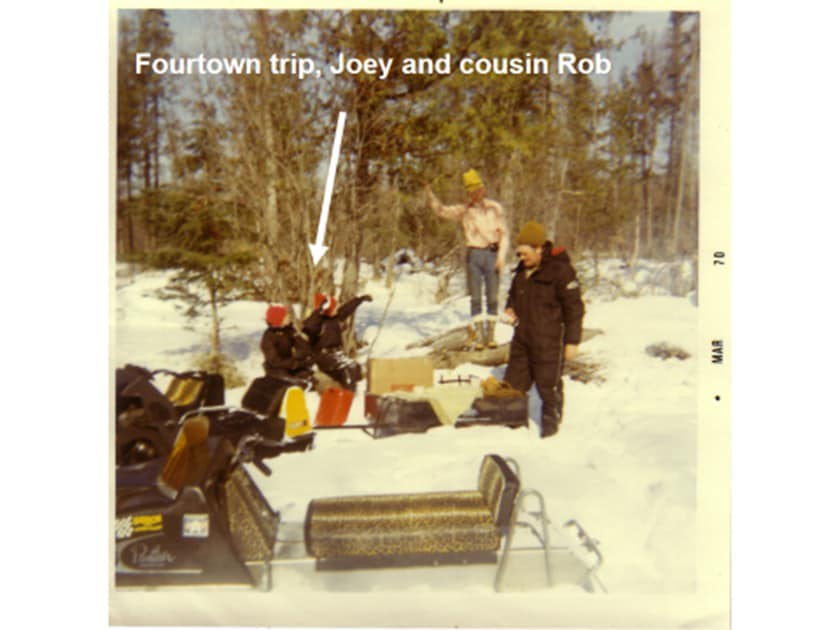
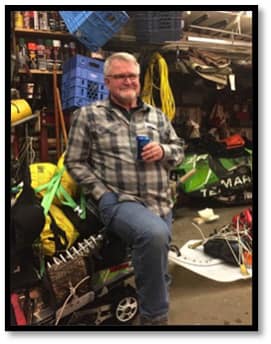
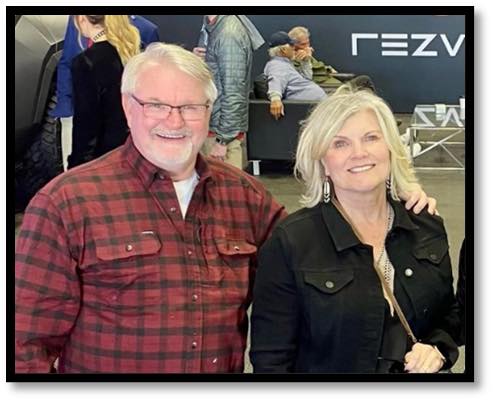
Last Sunday, we had an opportunity to highlight Rex Hibbert as he celebrated his 70th birthday on the trail. We felt it only made sense to share a bit more about the other two guys crazy enough to ride into this adventure as well.
Today, I’ll share about Rob Hallstrom, the baby of the group at the age of 65 (for another month or so). Like the other Guys, Rob has been riding snowmobile for more than 50 years—first riding a 10-horse, early 1960s Ski-Doo snowmobile in circles around the baseball field in the backyard of the Hallstrom home in Centerville, MN. When he was in 11th grade, his family moved to Thief River Falls, MN, hometown of his parents. From the youngest age, riding has been a core tenant of Rob’s life and if the “Hallstrom” name sounds familiar it may be because his father, Hank Hallstrom led the Arctic Cat Safety Department for many years and rode in the Iron Dog Ambassador Class at the age of 68 in 2004- he was the oldest guy to have ever run it at that time, or perhaps because his cousin, Joey, who he grew up riding with, is a former Team Arctic racer, race manager, and product marketing manager.
Now in retirement, Rob and his wife, MaJeana, live near Park Rapids, MN. Their daughter, Kasie, is married to Mike Plekkenpol, and they have two “tweenagers” following along on Grandpa’s wild ride. During the 3 Old Guys Ride to Alaska adventure, it has been me, Kasie, who has been writing/preparing most of the Facebook page posts. Rob has been doing the “Trail Reports” when he is able.
But snowmobiling is only one piece of what makes up Rob’s passions, as a lifelong outdoor adventurer his undertakings go far beyond snowmobiling; he is an avid hunter, canoeist, adventure bike rider, and off-road enthusiast. His earliest adventures—starting at age 12 and without adult supervision—included winter camping with his buddy, David Kolden, in a cabin near the remote community of Four Town, MN. He and Dave also ventured to Isle Royale as young kids where Rob recalls running out of food and money; they had one last candy bar and decided the first one to jump into Lake Superior would get the candy bar.
His love for the “North Country” started at a young age and when Rob was 21, he worked as a hunting guide and wrangler for a big game outfitter in British Columbia. (And yes, he did get frightfully close to grizzly bears!) At the end of the season, he was able to take a mountain goat –that mount is still hanging on a wall in the Hallstrom hunting shack. He has spent much of his life traveling, reading and studying both Canada and Alaska.
The “Cain’s Quest” snowmobile challenge—a 2500-mile endurance race—in Newfoundland and Labrador became a goal when he learned about the event from his cousin Joey. Joey had introduced Rob to Paul Dick, who had recently run that race with his teammate, Rex Hibbert. Beginning in 2010, Rob and teammate, Mike Dolby, began prepping for that event, including taking an official mechanics training course at Arctic Cat headquarters. Rob and Mike participated in that grueling competition in 2011, and Rob ran it again in 2012 with former Team Arctic Cat racer and engineer, Jason Howell. In 2019, Rob, Rex, and Paul made their 3,000-mile round trip snowmobile ride from Grand Rapids, MN, to Churchill, MB.
Sometimes the adventures seem too many to count – from riding the 3,000-mile Canada-to-Mexico Continental Divide route on dirt bike, taking multi-week fly-in canoe trips to Canadian waters, or riding to Alaska on snowmobile! When Rob and MaJeana were dating, he promised to bring adventure to her life, he has more than delivered on that! They will celebrate their 43rd wedding anniversary in August.
DAY 29 / APRIL 3
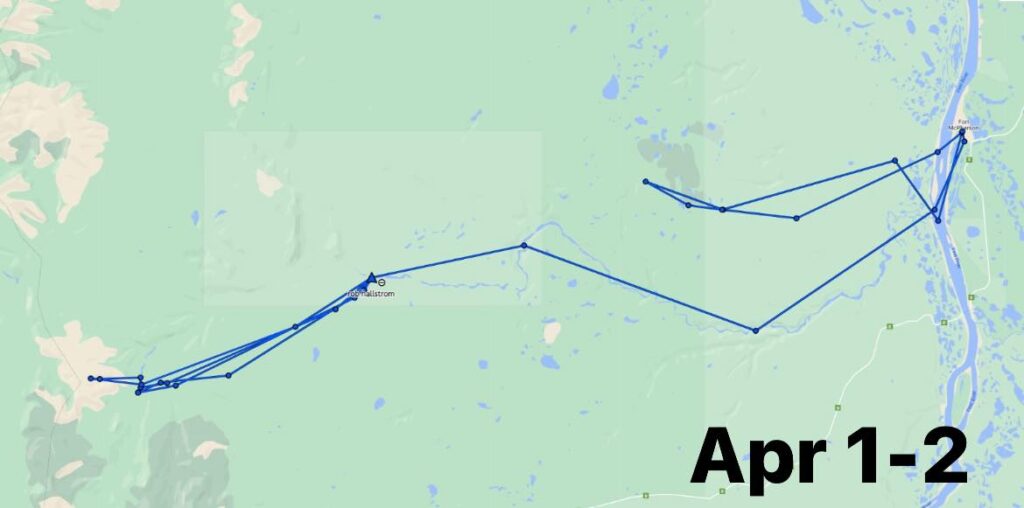
Guys were up and moving early this morning and have been making steady progress across the mountains. Thankfully, limited backtracking today gives us confidence that they’re on the trail. We would expect Rex to be leading the trio today as the experienced “mountain rider” in the group. As they head towards Old Crow, they are nearing Lapierre House.
Lapierre House, originally located near Fort McPherson, was a Hudson Bay Fur trade post built in 1846. It was relocated in 1851 to the present site along the Waters River west of Fort McPherson and east of the community of Old Crow to support travelers between Fort McPherson and the Yukon River by providing a reliable supply of caribou meat. Records from Lapierre House indicate that the Gwich’in brought in mostly meat to trade rather than furs.
Lapierre house changed hands multiple times over the years and saw many native and private traders, but by the late 1930s it was all but abandoned. While used only sporadically by local hunters and trappers, it remained an important stop on the route between Fort McPherson and Fort Yukon for many. – maybe even for our 3 Old Guys?
Interestingly, because of it’s unique location at the edge of the tree line and into the permafrost region, Lapierre House also supported a number of scientific expeditions including an American naturalist under the auspices of the Smithsonian Institution.
Today, Lapierre House is a historic site cooperatively owned and managed by the Yukon Government and the Vuntut Gwichin First Nation.
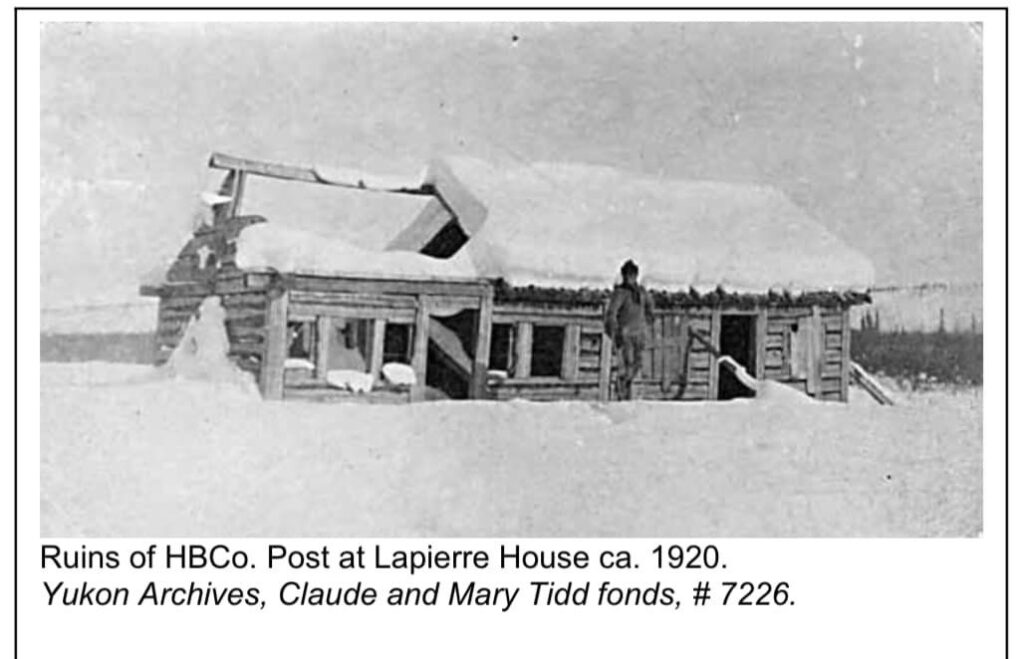
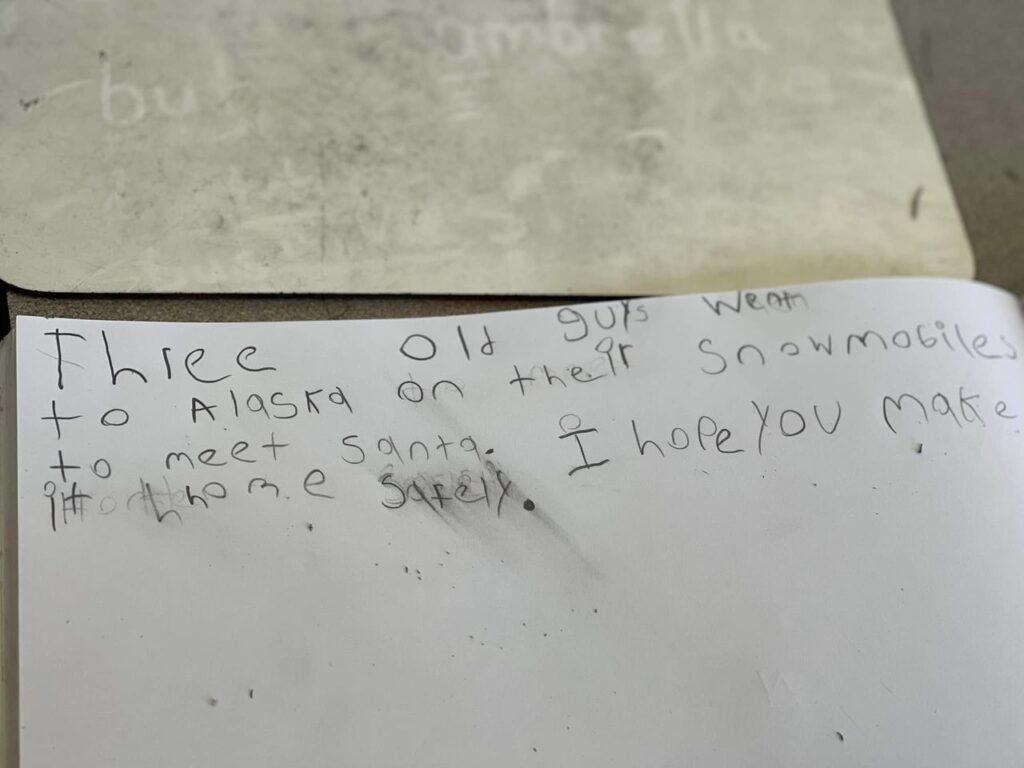
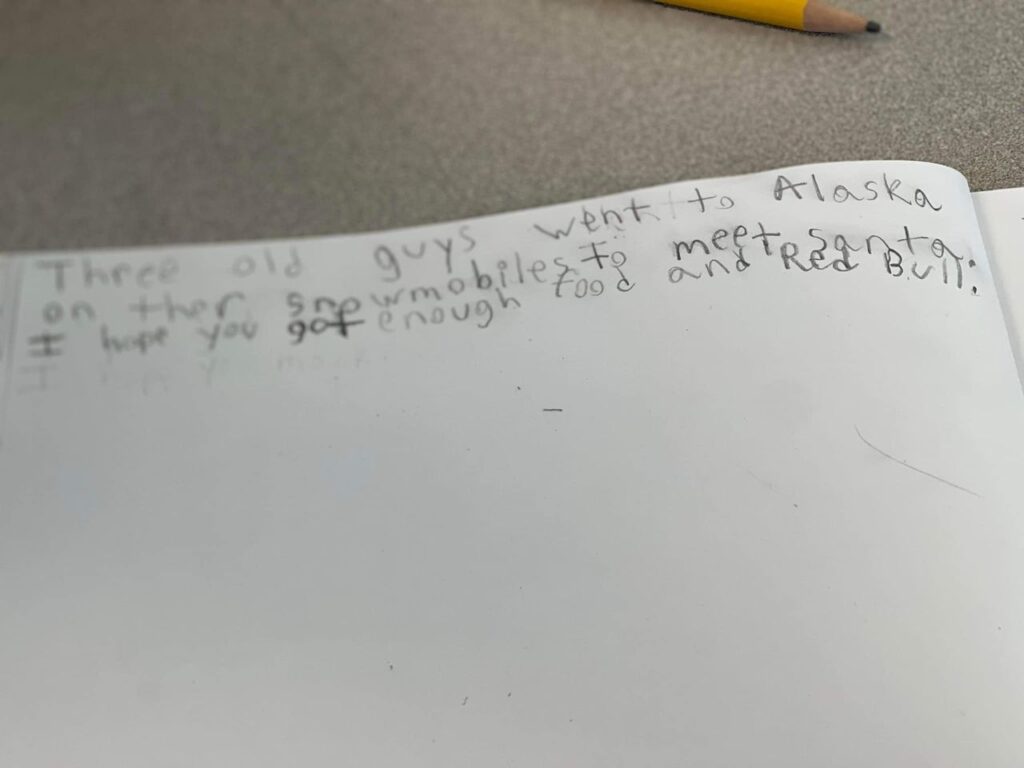
Evening Update – Guys have made it to the Porcupine River. They are reporting that river conditions appear less challenging than what they’ve faced the last few days but given “you never know what is around the corner,” they are taking rest in a cabin tonight and will hopefully complete their journey into Old Crow tomorrow.
We received a note from one of our Followers sharing how the kids in Upstate New York are using the 3 Old Guys to learn about geography and adventure- I couldn’t resist sharing the well wishes from these third grade students (see pictures).
Behind the scenes snapshot from Kasie:
When the 3 Old Guys were preparing for their departure, my dad, Rob, asked me to put up “a few” Facebook posts while they were on their ride since they wouldn’t regularly have service. He supplied me with 4-6 suggestions for material and even a couple pictures which we assumed would cover it.
You see, the 3 Old Guys literally thought they were just going out for a ride…none of us, and especially them, anticipated the following that they have garnered.
So…each day, along with many of you and the students following along, I learn about the history and the trek that the 3 Old Guys have spent years researching. I am particularly thankful for Les Oystryk, a retired Conservation Officer and Historian who supplied my dad with intel prior to departure and who has become a wealth of knowledge for my regular posts. This journey has certainly been a fun and wild ride for us all!
DAY 30 / APRIL 4
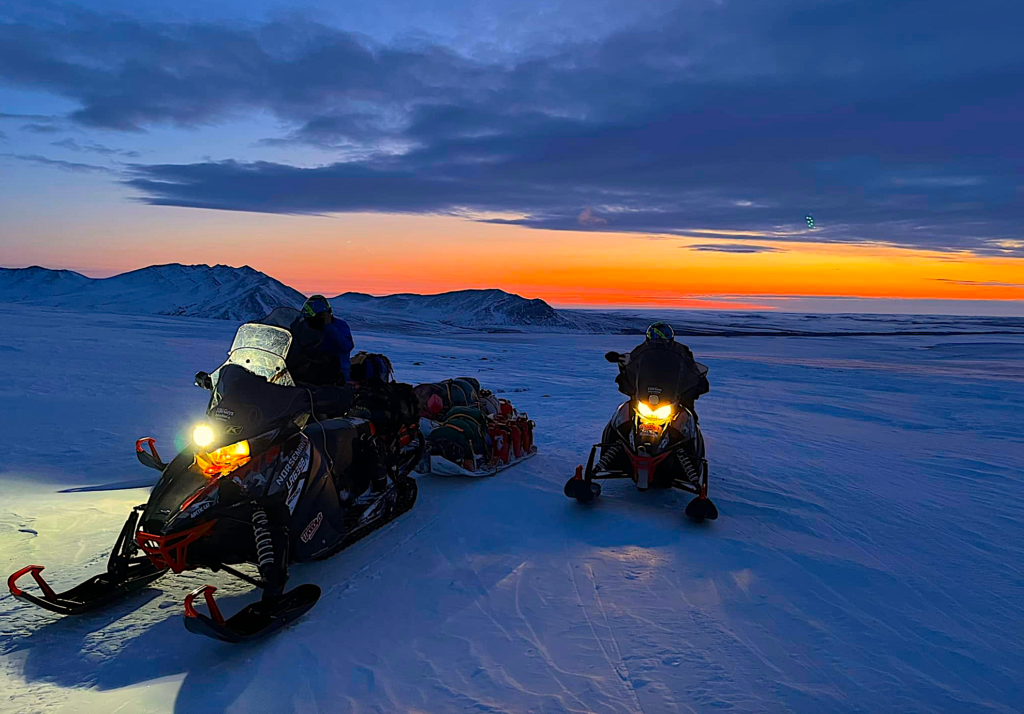
Consider this your trail report (for the past few days), albeit conveyed by Kasie
The Richardson Mountains didn’t give up easy, but after a tough few days, the 3 Old Guys made it to Old Crow this afternoon. The Guys are reporting in that they have logged an estimated 4,500-5,000 of hard miles and everything is getting tired. In fact, when they arrived into town today one individual commented, “You guys look tired” – fortunately, while they agree that they are indeed tired, they are still laughing, still upbeat, and still healthy.
Upon arriving in Old Crow, they stopped at the Co-op where they understood there were a couple of rooms; they were told that no rooms were available tonight when a woman walked in and said curiously, “are you the 3 Old Guys?”…. “we have a cabin waiting for you” – what a wonderful journey to be welcomed with such hospitality! The guys were escorted to a local’s home where they had a spare cabin with a woodstove for the guys to stay in. They spent the afternoon speaking with her husband about the trail ahead, described as “330 miles of no trail.”
Hearing the trek ahead will be a continued challenge, the Guys immediately took to assessing the sleds. In Inuvik they proactively changed out some parts, but they have still been having problems with the clutches, putting grease on them to get by; after evaluating the machines today, it was determined that they will need to stay in Old Crow until clutch parts can be flown in and the necessary repairs can be made- however long that takes. (Note – we have a plan in motion)
The Guys do not have service in Old Crow, so our first communication via GPS messaging went a bit like this “Old Crow. Need 2 Driven Clutch. At least sleeve. Daily flight Whitehorse.” – You can imagine the stir these types of messages cause the “home-front” crew as calls and texts start flying between the critical few that can act, while simultaneously informing the broader group of the good and bad news coming in from the trail.
A few hours after the initial stir occurred today, I received an unexpected, but welcome, call from Rob – note this is the first time that we have heard from him, aside from brief GPS messages since Friday (Mar 31). While he does not have service, he was able to go back to the Co-op and briefly connect to their internet so that he could check-in and – lucky for us – provide a proper trail update from the last few days; I will do my best to share their tale:
When the 3 Old Guys finally departed Fort McPherson on Saturday (Apr 1) and got going on the correct route, they had a good trail all the way to the first cabin, they ventured forward but quickly found themselves on open, barren land. They knew they were supposed to go by a creek and would find bits and pieces of prior track, but struggled to find the right trail. As dusk approached, they made the decision to head back to the first cabin for the night and make a fresh start in the morning.
With an early start on Apr 2, the guys re-evaluated the trek they had taken the prior day. With the terrain as it was, Rob and Rex went ahead to assess while Paul stayed with the sleighs. They were able to get up near the creek, but still were unclear on where the trail went. They decided to park the sleds and walk – this is when Rob went through the ice. Wet up just past his knees and in frigid temperatures the two Old Guys quickly returned to the sleds and Paul where Rob put on his overcoat, emptied his Bunny boots and put on dry clothes.
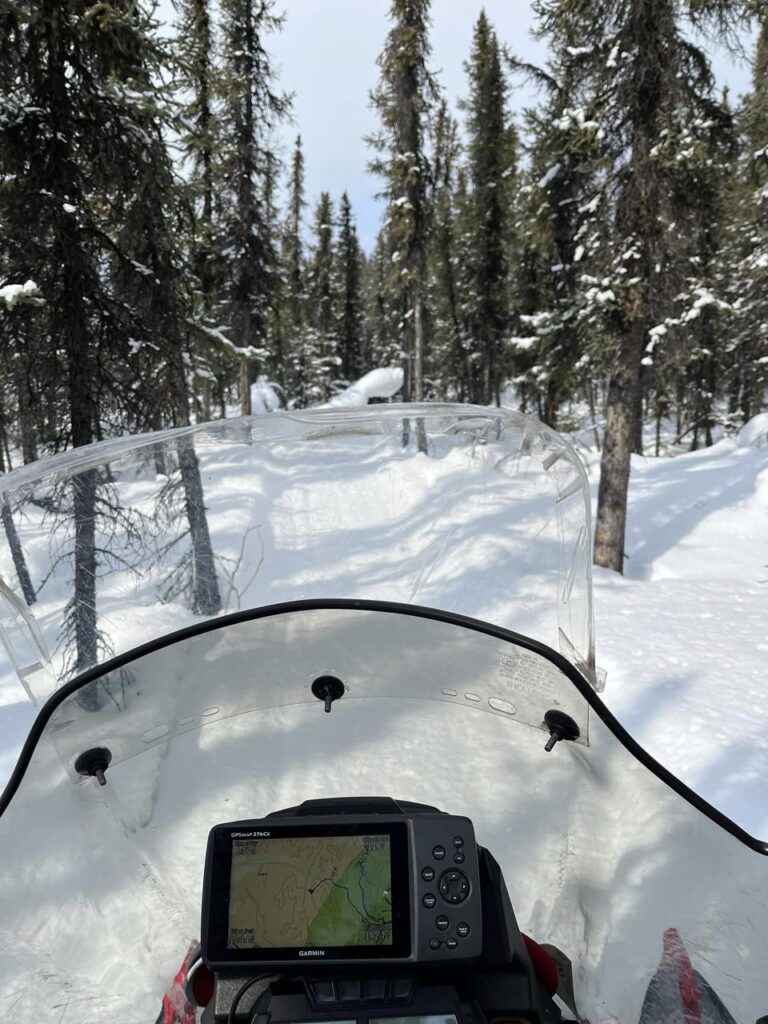
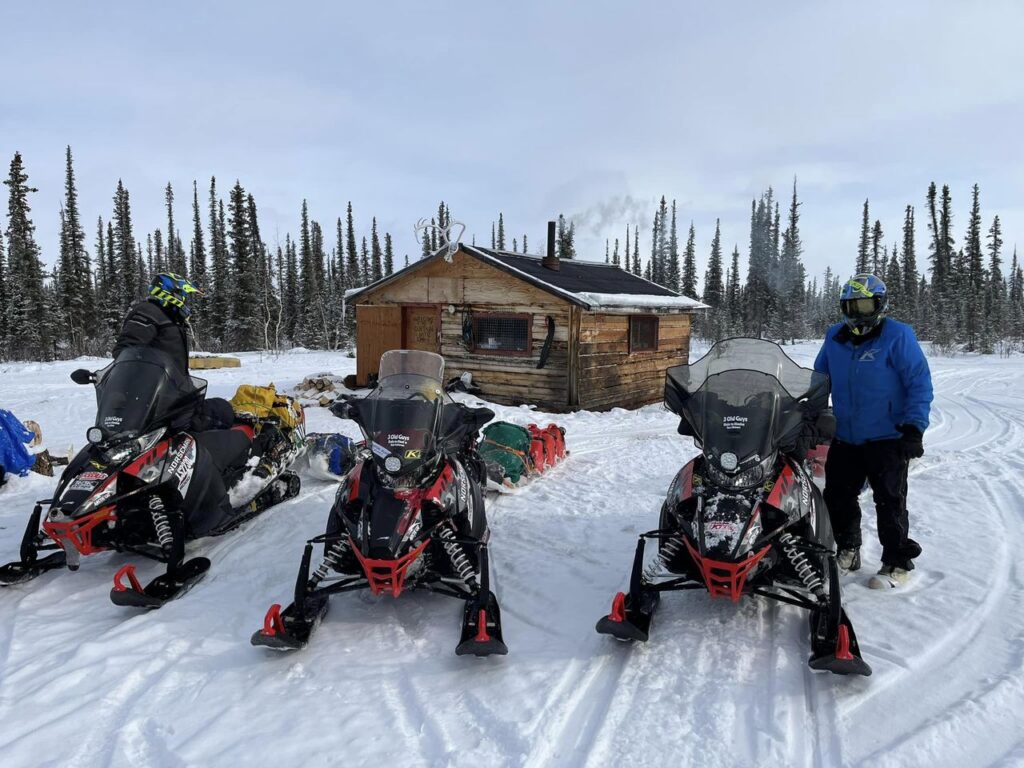
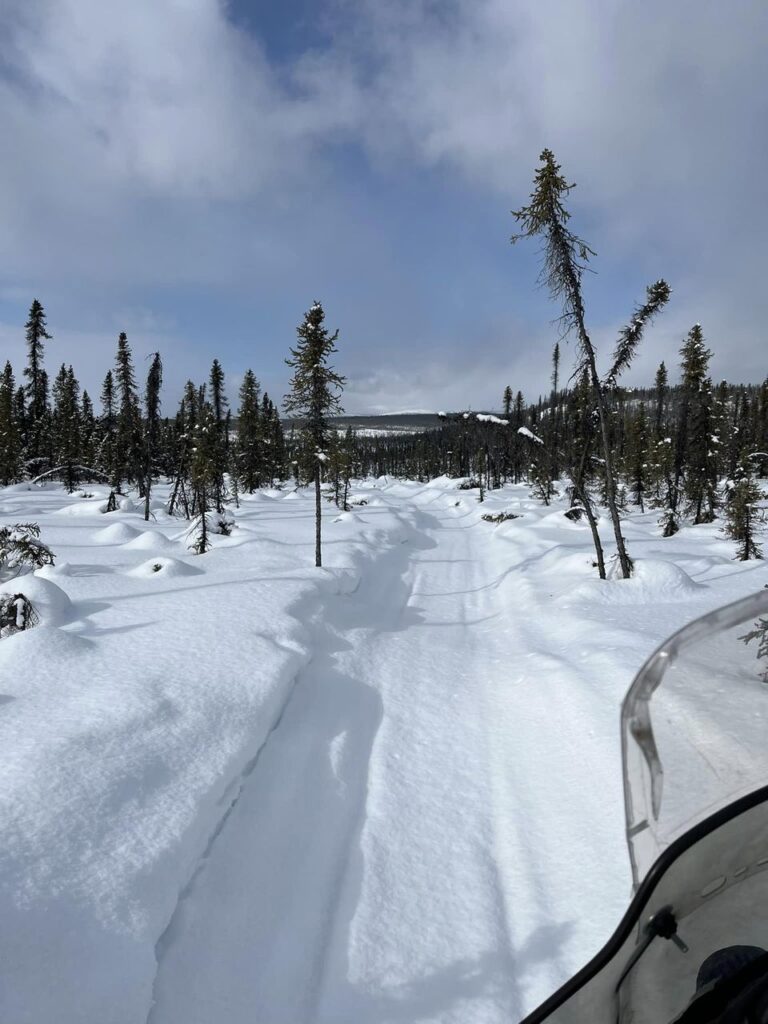
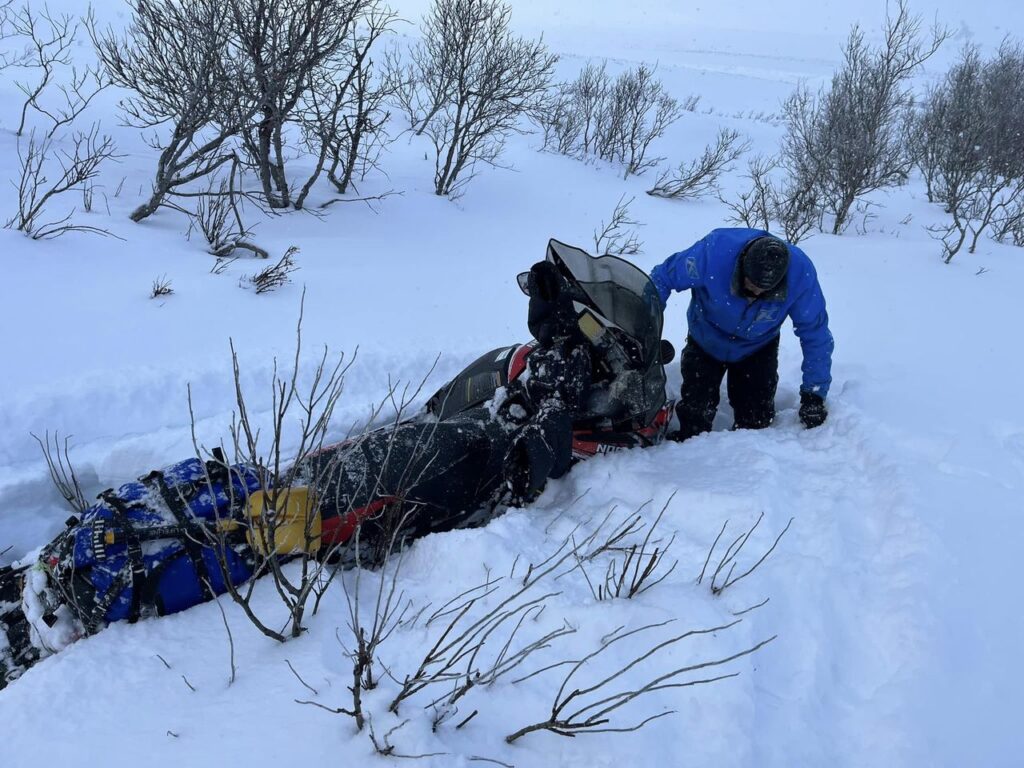
It was about this same time, as Rob was getting dry, when two First Nations people showed up on a single Ski-Doo. They were coming to connect with some others and guide them over the pass. What perfect timing! The 3 Old Guys followed as these locals steered them in a much different direction than they expected to a steep chute – “seemed nearly vertical” to the top of the pass. Once they reached the top “the wind was so fierce you could not see more than 15-20 yards in front of you.” The local experts immediately said it was too dangerous and that they needed to turn back – and so they did. While the guides headed back to Fort McPherson, the 3 Old Guys retreated back to the first cabin for a second night. Prior to departing from the locals, they got some directions on the trail for the morning, which the Old Guys say was as clear as mud to them, “Go this way, Take the creek, It is the only trail, Can’t miss it.”
The 3 Old Guys climbed the chute again the morning of Apr 3, this time as they reached the top they found an unexpected surprise: no snow, all rock and, of course, not a single track. They made their best guess on how to navigate their way down and finally found the creek, but it was loaded with deep snow. They made the decision to leave the sleighs again and Rob and Rex road ahead to break trail through the powder. After a short while, out of what seemed like nowhere to the Guys, another First Nations local appeared. He said he was there to guide another group, going the opposite direction, but that it was getting windy and he had to move quickly. The guys asked “where is the trail” and his simple reply, “you’re on it.”
He instructed them to follow him and that he would make a track for them. The Guys re-connected their sleighs and were able to swiftly follow his trail; about 30 minutes later a group of ~8 came through headed towards Fort McPherson under his supervision. Their tracks helped the Old Guys make much better time the remainder of the day to the Porcupine River. When they came to this intersection they were surprised to find the tracks went the opposite direction from Old Crow, upon further investigation they saw a small tipi and cabin just down the river a bit where the 3 Old Guys decided their safest bet was to rest for the night before heading to Old Crow this morning (Apr 4).
The ride into Old Crow was relatively mild considering the past few days. While there is a “trail” that connects Fort McPherson to Old Crow, this is not a modern trail that many of us may think of – it is not marked, it is not heavily packed down as only a few sleds ride it here and there – and between nearly every occasion that someone passes on this route it likely snows, the wind blows, and all evidence is lost, bringing it back to its peaceful state.
DAY 31 / APRIL 5TH
The guys continue to wait out parts in Old Crow, we assume they are using this break to get some much needed rest, discuss upcoming trail conditions, and further assess and maintain their equipment.
Continuing our spotlights on the 3 Old Guys, today seems like a great day to showcase Paul Dick. While Paul, like each of the Old Guys, brings a wealth of experience and skills to this ride, his years of competitive racing and mechanical expertise help guide this group in making the best decisions about sled set-up. His knowledge and insight on building and designing the “ideal” sled for the ride and remediating in times of challenge has helped to ensure that the guys are equipped to tackle this adventure. In fact, it was Paul’s shop serving as headquarters for snowmobile prep in advance of this expedition. It should be noted, that no one gets into Paul’s shop to inspect the sleds without high-security clearance, or a 12-pack of Budweiser!
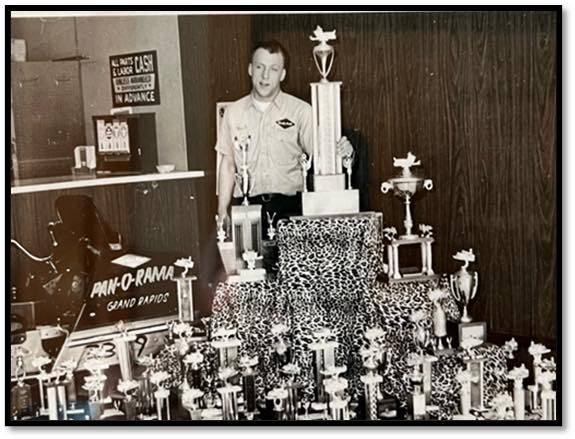
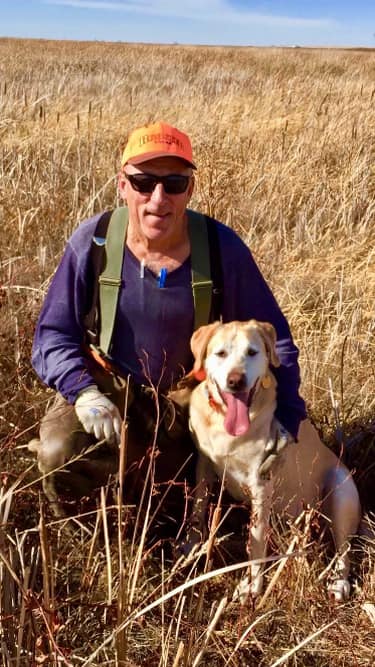
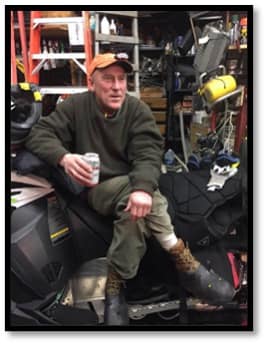

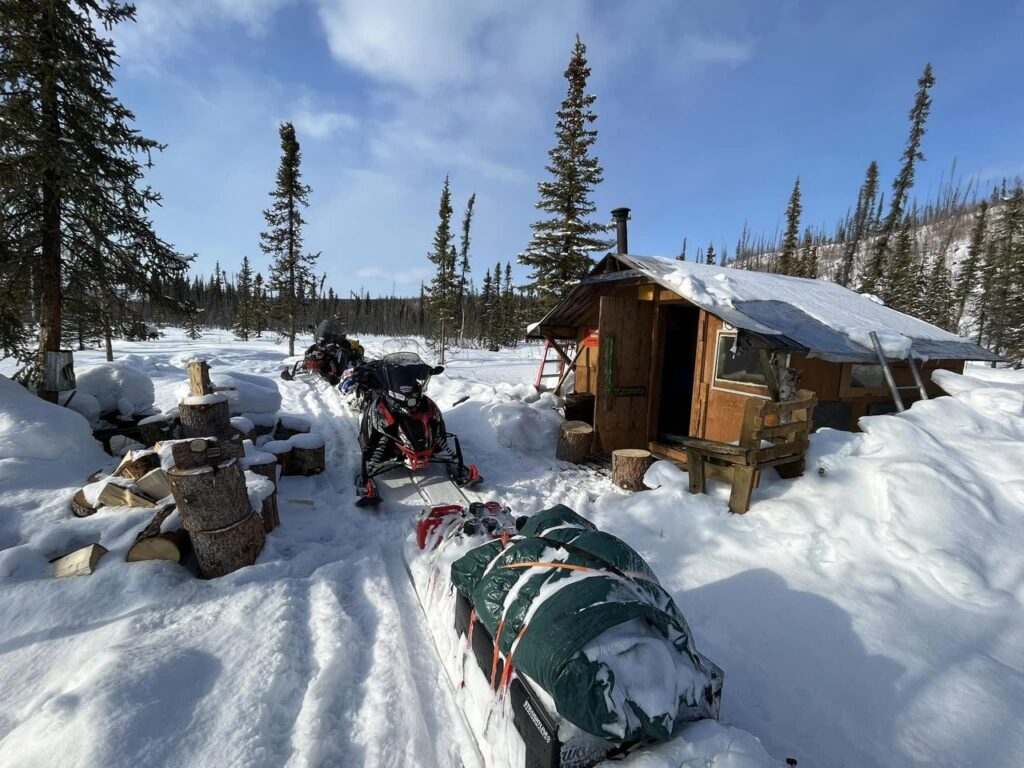
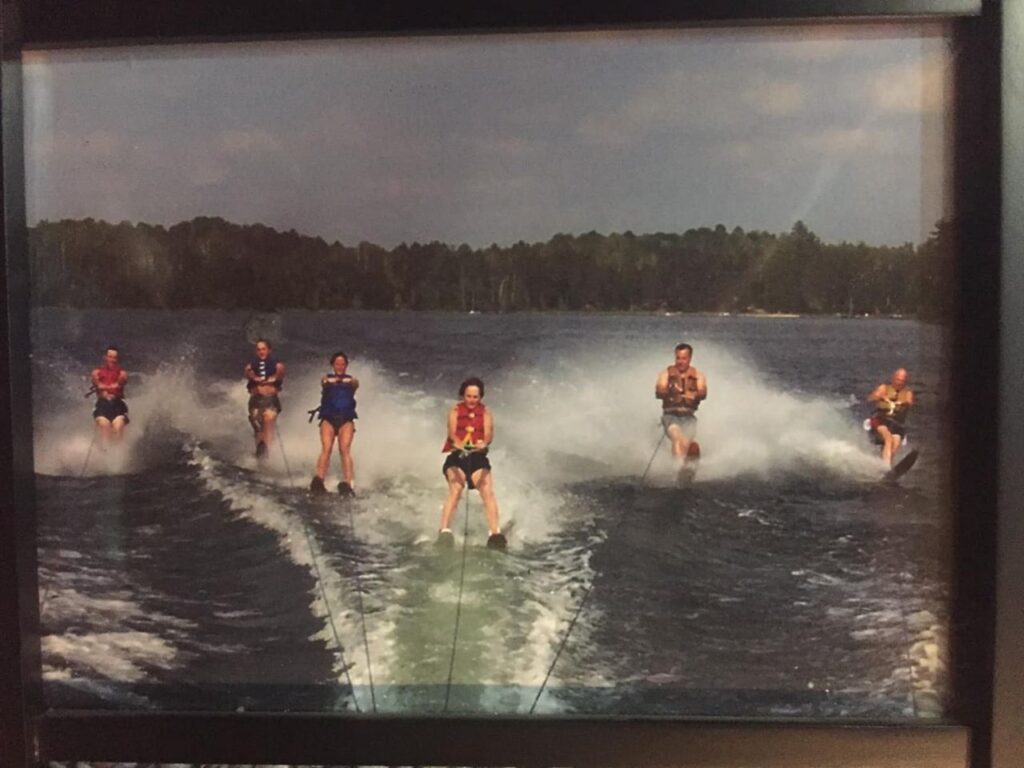
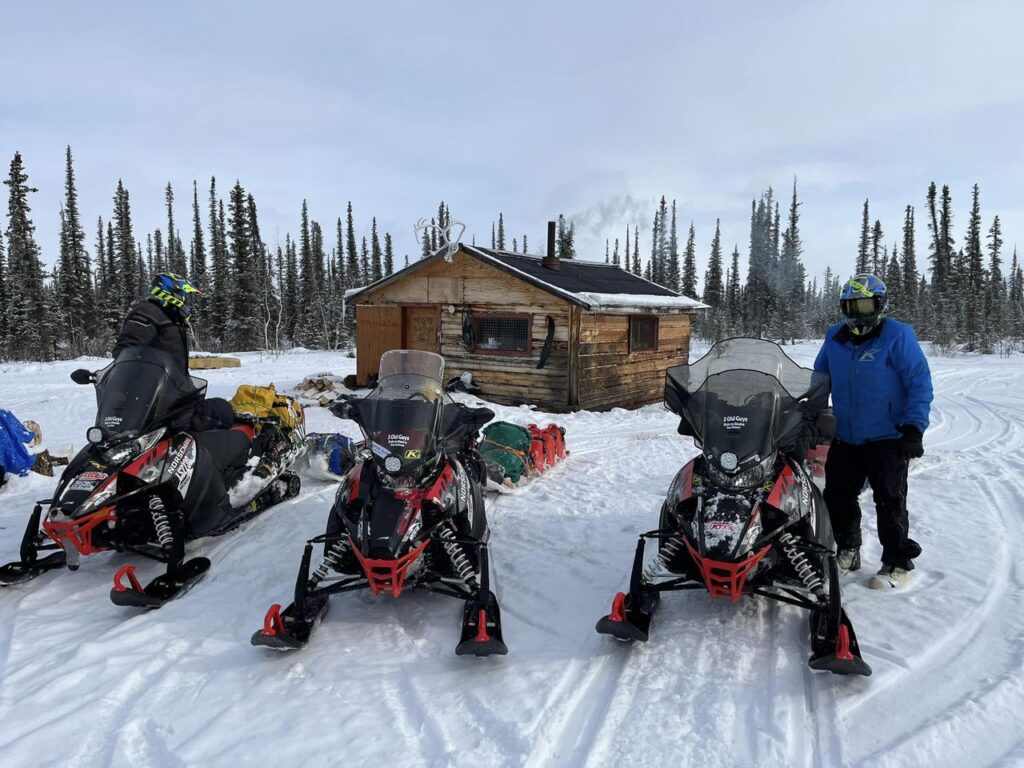
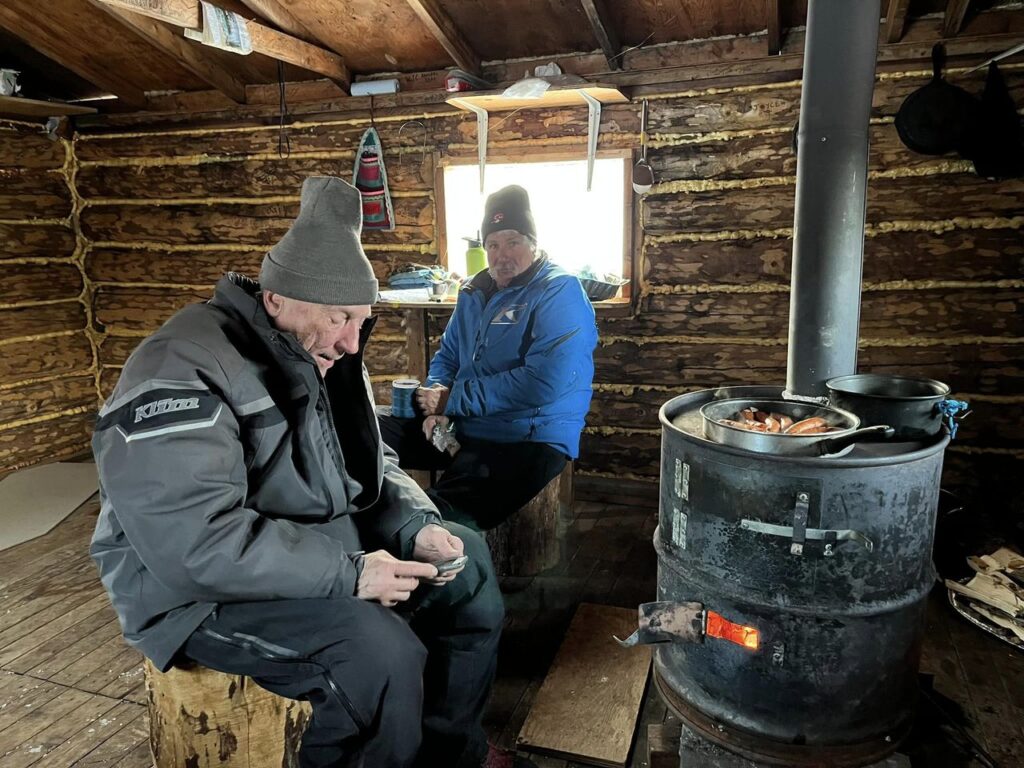
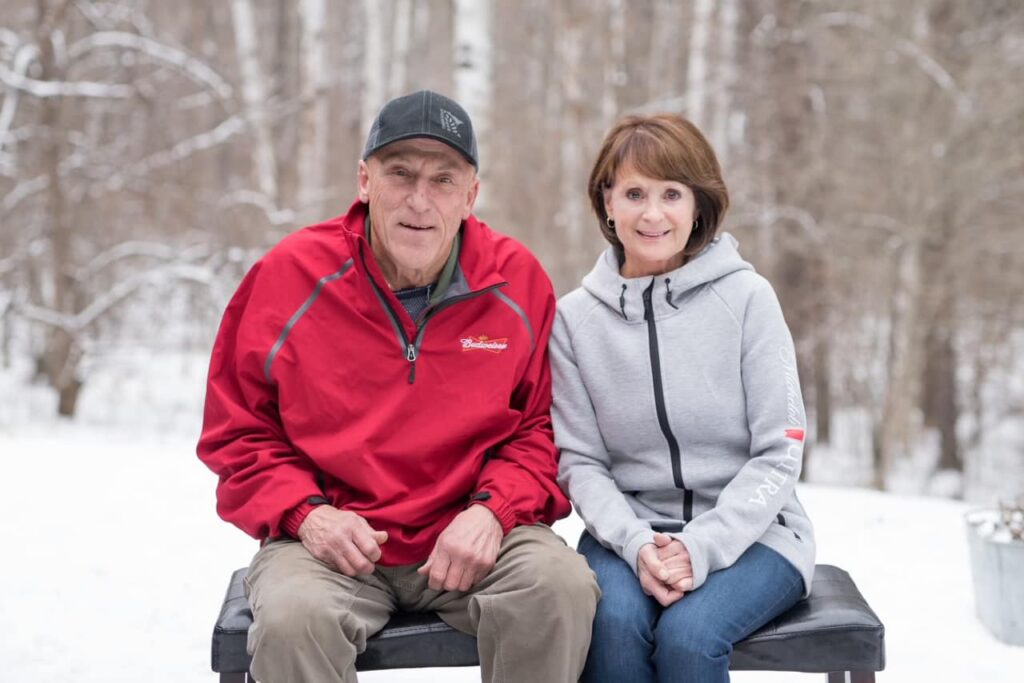
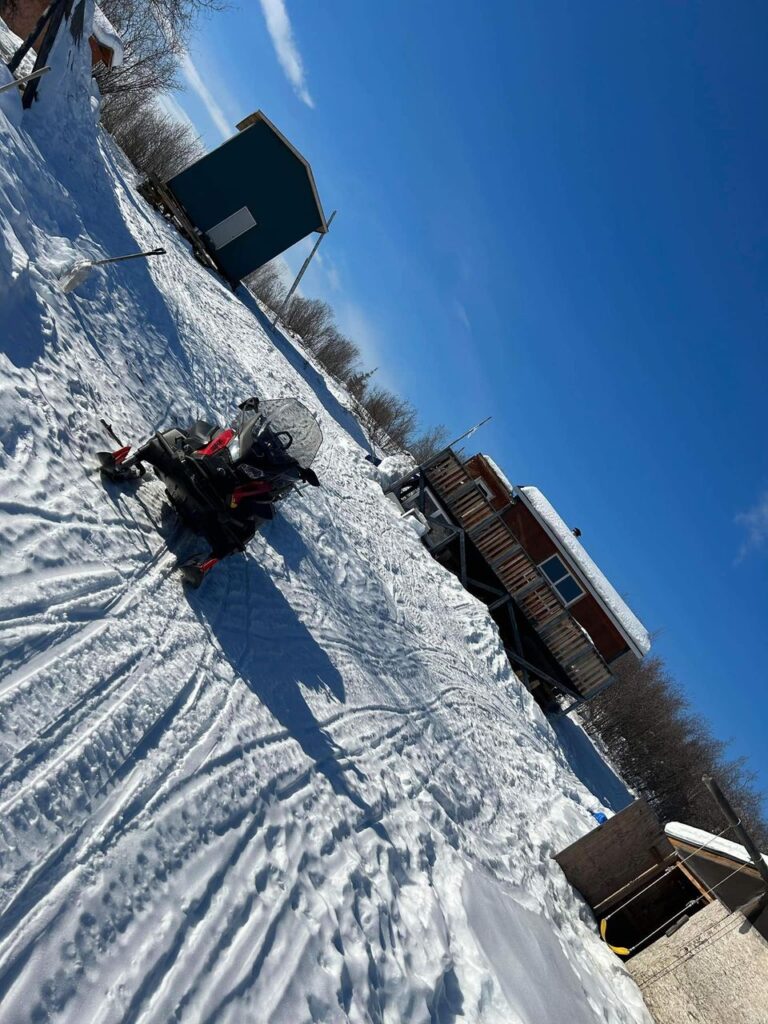
In addition to being the mechanical master, Paul is 72 years young and admittedly a “colorful” character. He is notably the only snowmobiler to have participated in all long-distance Cross Country snowmobile races in North America. His racing career began while he was in high school. During his 50+ years of racing, he has competed in the Winnipeg-to-St Paul Winter Carnival I-500, Jeep 500, ISOC I-500, USCC I-500, USXC I-500, Iron Dog Alaska snowmobile race, and Cain’s Quest. He and all three of his sons raced together in one of the 500s; how cool is that?! He raced three times in Cain’s Quest with Rex and twice in the Iron Dog – once with Rex and once with his son, Brian.
Paul learned a lot about snowmobiles and general fixes from his departed friend and mentor Bob “Cogs” Dewey, who supported Paul through all his years of racing. Paul has always had a passion for snowmobiling and enjoys riding with his family and friends. He resides in Grand Rapids, MN with his wife of 48 years, Judy; they have 4 children and 9 grandchildren. When there isn’t snow on the ground, Paul can be found hunting, fishing, doing projects at home or his family cabin, or cutting wood with his chainsaw or sawmill. I think his family and friends will agree…If they were stranded on a deserted island or on a mountain trail in the Yukon…he’s the man you’d want to be with!
We have received many inquiries about the cabins that the Old Guys hunker down in while out on the trail.
Throughout both Canada and Alaska there are many cabins available for public use. Nearly all cabins in this area are considered community cabins and left open and unlocked; generally, they consist of a combination of shelter cabins and trapper cabins.
Shelter cabins are cabins that have been built and established with the primary purpose of making winter travel along trails safer. These tend to be more public and well-known, and are generally maintained by a public entity such as the Forest Service or National Preserve. Cabins like these were built in honor of the Lost Patrol (see Facebook post from Mar 31) between Fort McPherson to Dawson.
The trapping of animals in Northern Canada has been core to the culture since the 1600s and continues today. In the 1930s Registered Fur Management Areas (RFMA) allocated parcels of public land to a registered trapper allowing for exclusive trapping privileges; the government recognized that trappers required buildings to live and work during harsh conditions; therefore, trappers were allowed to build cabins and sheds on within their RFMAs in locations that best served their needs. Until the 1990s, there was no permit requirement for these and most trappers used this privilege respectfully. These trapper cabins can be in varied areas across the countryside.
No matter the cabin, tradition in the northland is that when a traveler is in need of shelter and warmth while traveling they can make use of any cabin they come across as long as they leave it as they found it – or better. Typically, this means filling the wood box and ensuring it is ready for the next traveler to start the fire. Some cabins are well known and easily mapped in advance, others, such as a trapper cabin, may just be stumbled upon. Regardless, they are first come, first served, but you may have company and courtesy is to welcome any neighbor in need, particularly in emergency situations.
Some of these cabins may be empty with a basic wood floor, stove and a counter window. Others may be equipped with bunks and other amenities. In some more “modern” cabins there is often a log book for visitors to sign and leave a note that they had passed through.



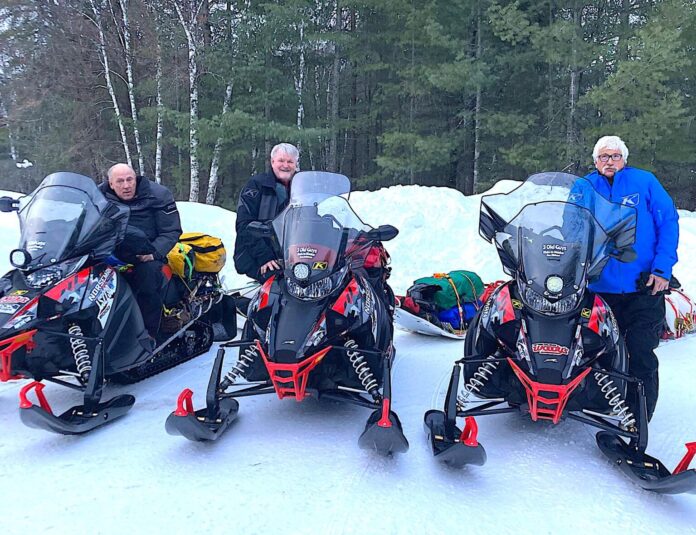
Even in today’s modern world 3 Old Guys can find adventure! Well done!
I’d like to know what happened to the secondaries ? And why they were applying grease and where ? I can see if the bushing went out of the helix. But he said they only needed sheaves ? Plus didn’t the grease fly all over the belt ? Did the heavy sleighs wear out the clutches premature ?
As far as those clutches go. Just the weight of the fuel alone without any gear, would be 180 lbs. to 216 lbs. depending on whether the fuel cans were 5 or 6 gal. containers. Operating for that length of time in those conditions tugging around that much weight, would tend to keep you at low rpm’s for long periods. Thus, it would keep the belt in the same spot in the sheaves and cause the sheaves and the belt to overheat. I would think it’s possible those secondary sheaves could burn through. Congrats to those gentlemen.
Are you in great need of credit rebuild? In order to get better rates/ low interest loans. I strongly recommend JERRYLINK CREDIT GROUP. They are top notch in terms of credit fix. They helped me delete negative items on my report, and my score rose to excellent.